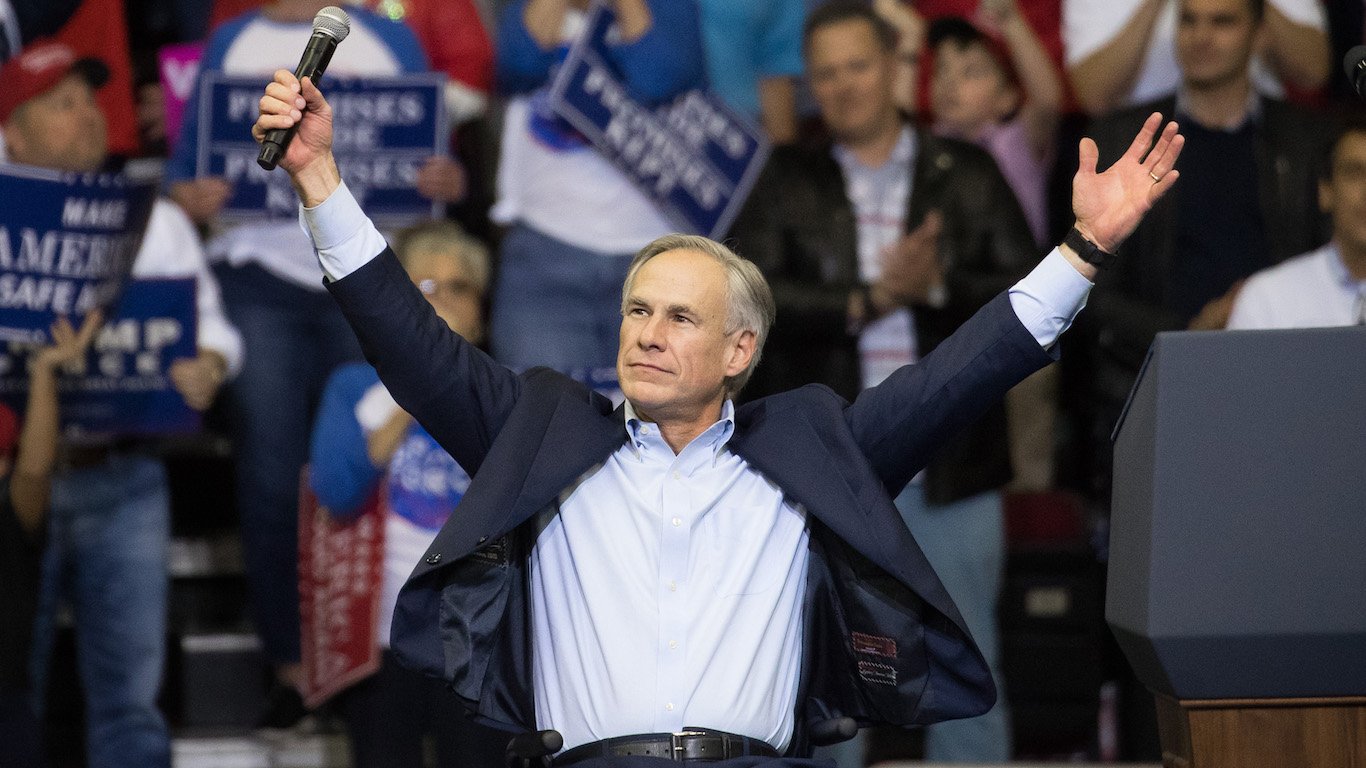

Governors are the most powerful elected officials in state governments, effectively serving as the chief executive. Unlike CEOs in the private sector, however, governors face re-election every few years — and for those who want to keep their job, popularity is of chief importance.
Though all 50 state governors are popularly elected, public opinion continues to evolve long after campaign season ends and the polls close on election day. Right or wrong, public opinion is influenced by any number of factors, from the germane to the trivial.
24/7 Wall St. reviewed public opinion data from research company Morning Consult to identify America’s most popular governors. Approval ratings are based on survey data collected during the third quarter of 2018 and range from 17% to 70%.
Because this survey was conducted in 2018 and more than a dozen states are swearing in new governors in January 2019, not all governors on this list are still in office. While some were forced to step down by state-imposed term limits, others — like Scott Walker in Wisconsin and Bruce Rauner in Illinois — were voted out of office.
Of the 50 governors on this list, 33 are Republicans. All 10 of the most popular governors are Republican — as are seven of the 10 least popular.
Click here to see the most popular governors.
Correction: In a previous version of this story, we incorrectly stated that the Virginia Gov. Ralph Northam could run for office again in 2021. In fact, Virginia does not allow governors to serve for two consecutive terms. This error has been corrected.
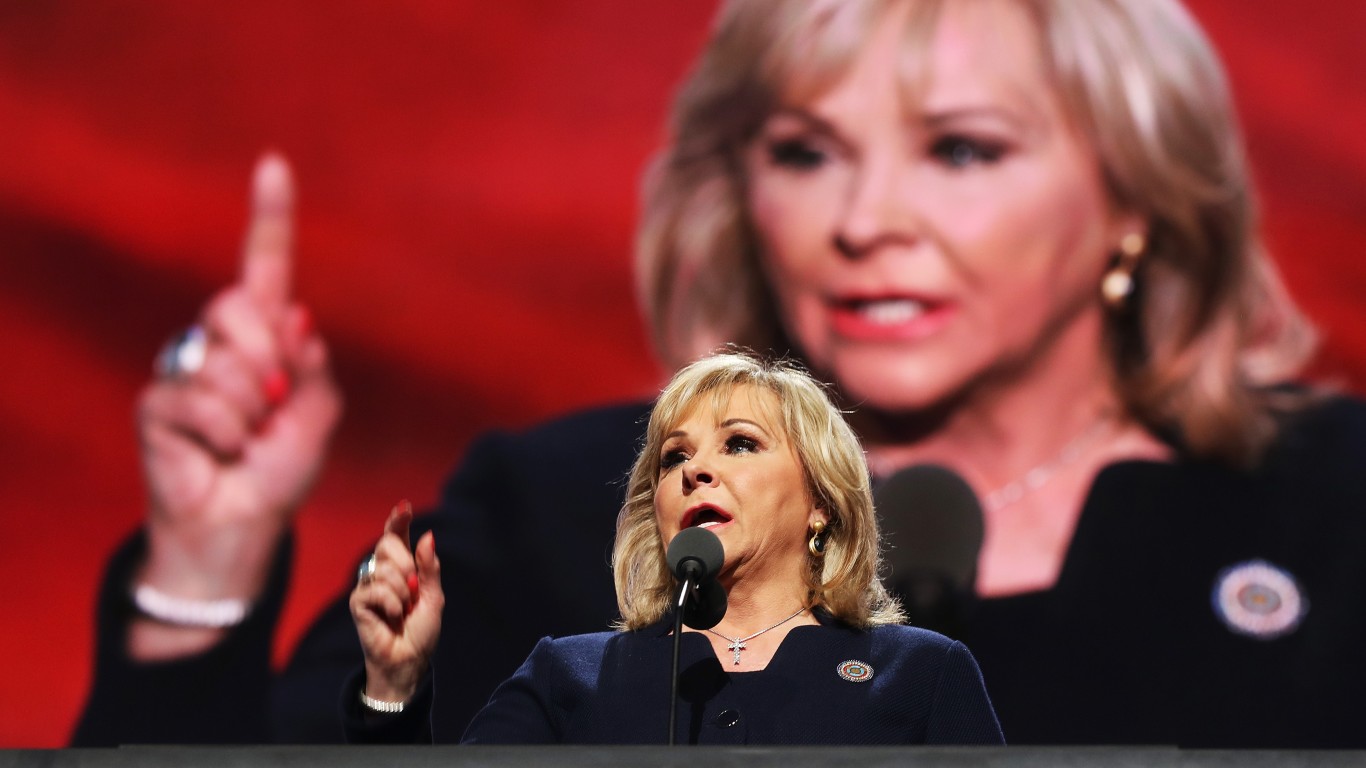
50. Gov. Mary Fallin (R) of Oklahoma
> Approval rating: 17%
> Disapproval rating: 75%
> Tenure: 8 years
> Nov. 2018 state unemployment: 3.3% (15th lowest)
Mary Fallin will step down as governor of Oklahoma in January 2019 after serving two terms, the maximum allowed by state law. Republican Kevin Stitt will take the top job after defeating Democratic opponent Drew Edmondson in the general election. Fallin leaves office with the lowest approval rating of any governor.
[in-text-ad]
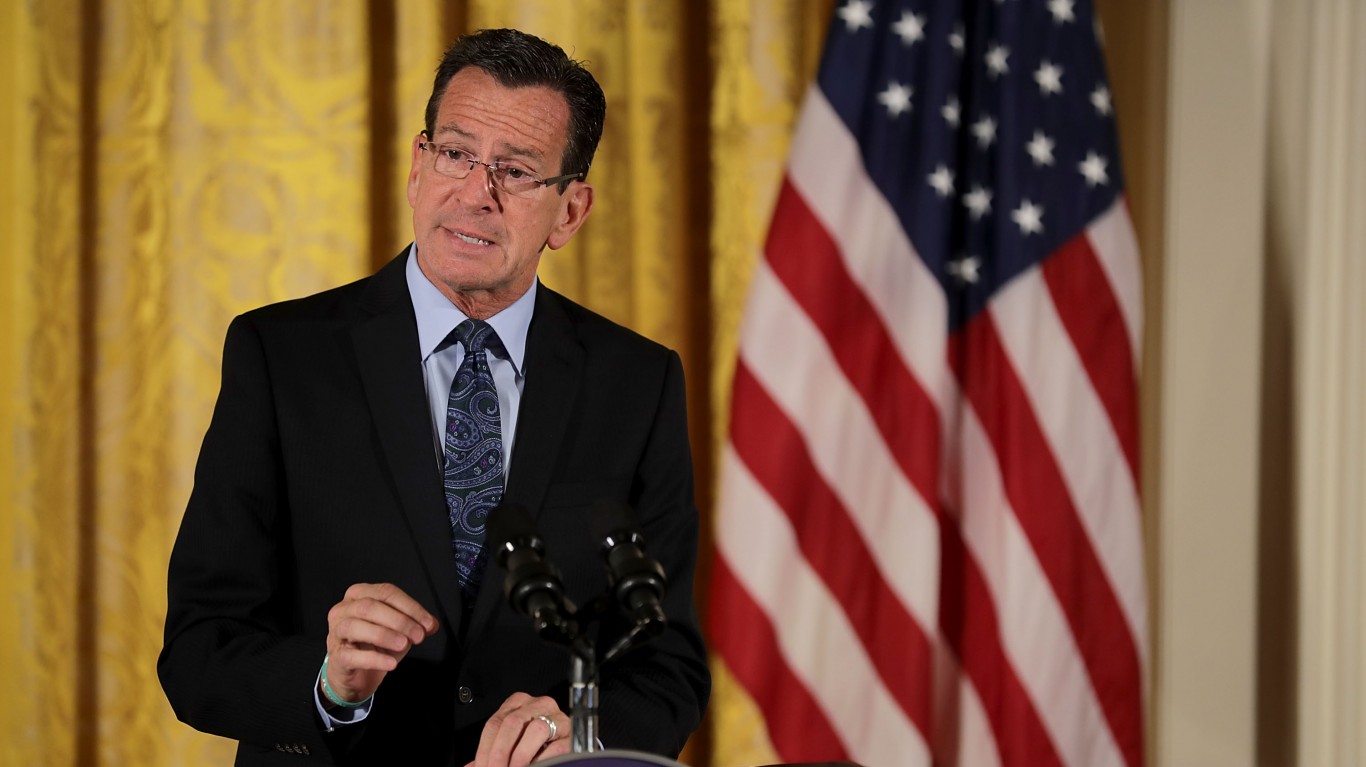
49. Gov. Dan Malloy (D) of Connecticut
> Approval rating: 20%
> Disapproval rating: 70%
> Tenure: 8 years
> Nov. 2018 state unemployment: 4.1% (15th highest)
Serving as Connecticut governor since 2011, Dan Malloy did not seek a third term. Malloy’s last day in office will come in January 2019 and Democrat Ned Lamont will take the job. Malloy maintains his low approval rating was not a factor in his decision not to run.
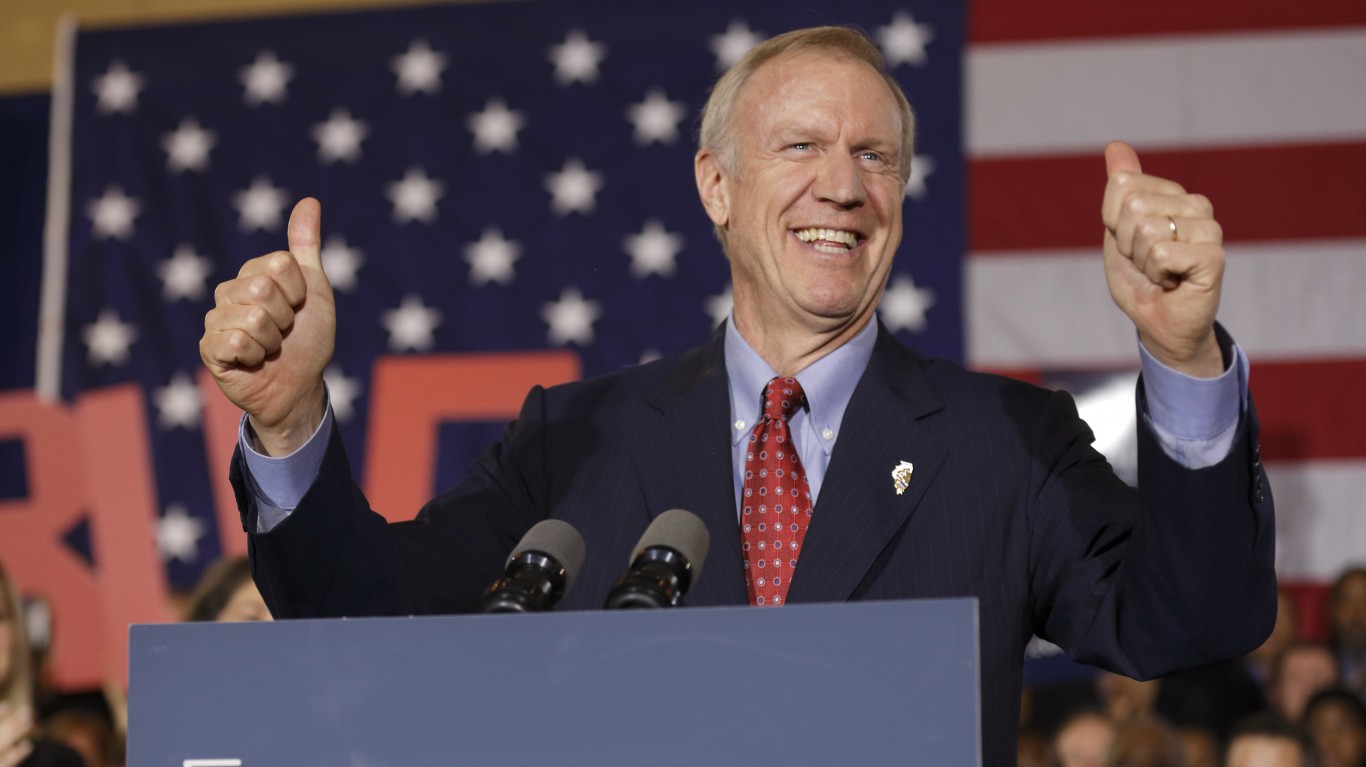
48. Gov. Bruce Rauner (R) of Illinois
> Approval rating: 25%
> Disapproval rating: 62%
> Tenure: 4 years
> Nov. 2018 state unemployment: 4.2% (12th highest)
Incumbent Republican Gov. Bruce Rauner lost to Democratic challenger J.B. Pritzker in the 2018 general election by a staggering 15 point spread. Rauner’s 25% approval rating was the lowest of any incumbent running for re-election.

47. Gov. Bill Walker (I) of Alaska
> Approval rating: 25%
> Disapproval rating: 54%
> Tenure: 4 years
> Nov. 2018 state unemployment: 6.3% (the highest)
Bill Walker served as governor of Alaska from December 2014 until December 2018, about two months after he suspended his re-election campaign. Walker, who served during tough economic times in Alaska precipitated by plummeting oil prices, left office with nearly the lowest approval rating of any sitting governor. Alaska has the nation’s highest unemployment rate.
[in-text-ad-2]
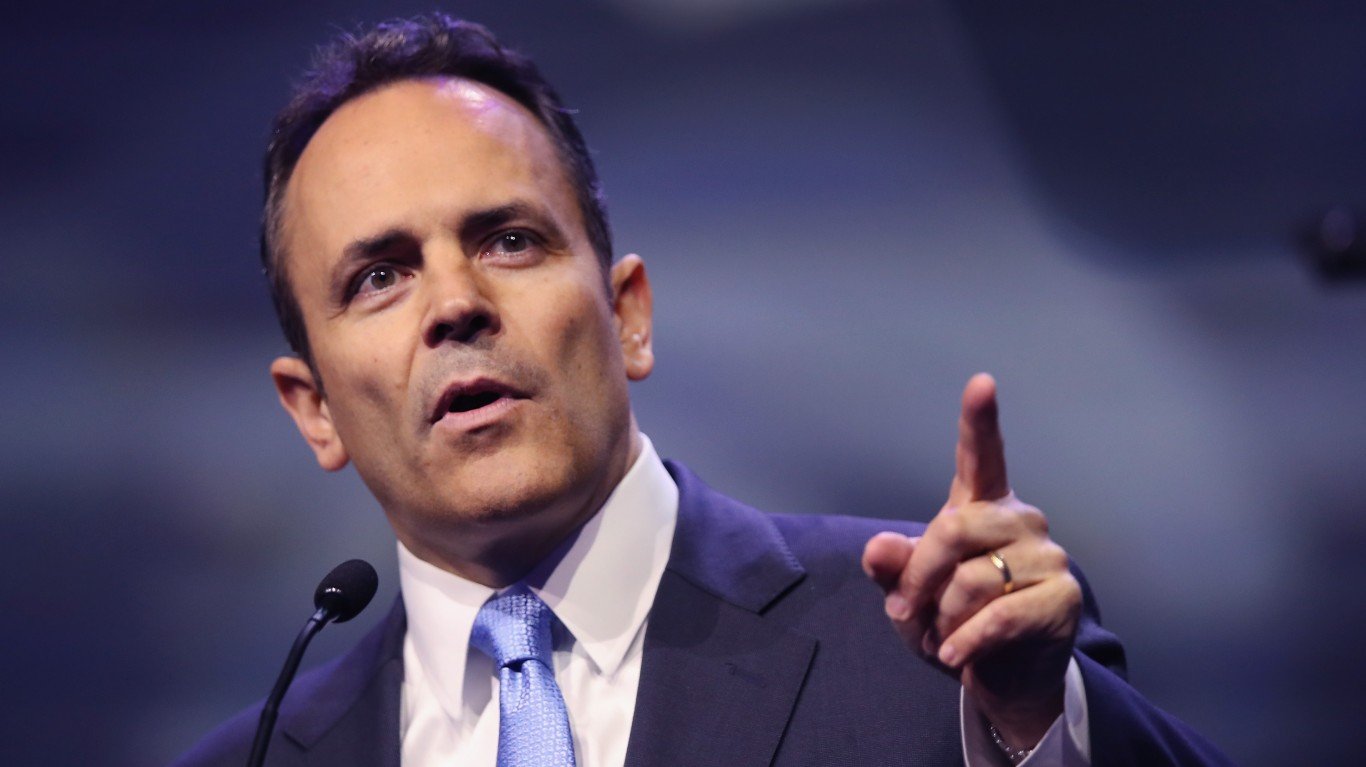
46. Gov. Matt Bevin (R) of Kentucky
> Approval rating: 30%
> Disapproval rating: 55%
> Tenure: 3 years
> Nov. 2018 state unemployment: 4.5% (8th highest)
Matt Bevin was sworn in as as governor of Kentucky in December 2015 after defeating Democrat Jack Conway the previous month with 52.5% of the vote. Bevin intends to run for re-election in 2019 despite a 30% approval rating.
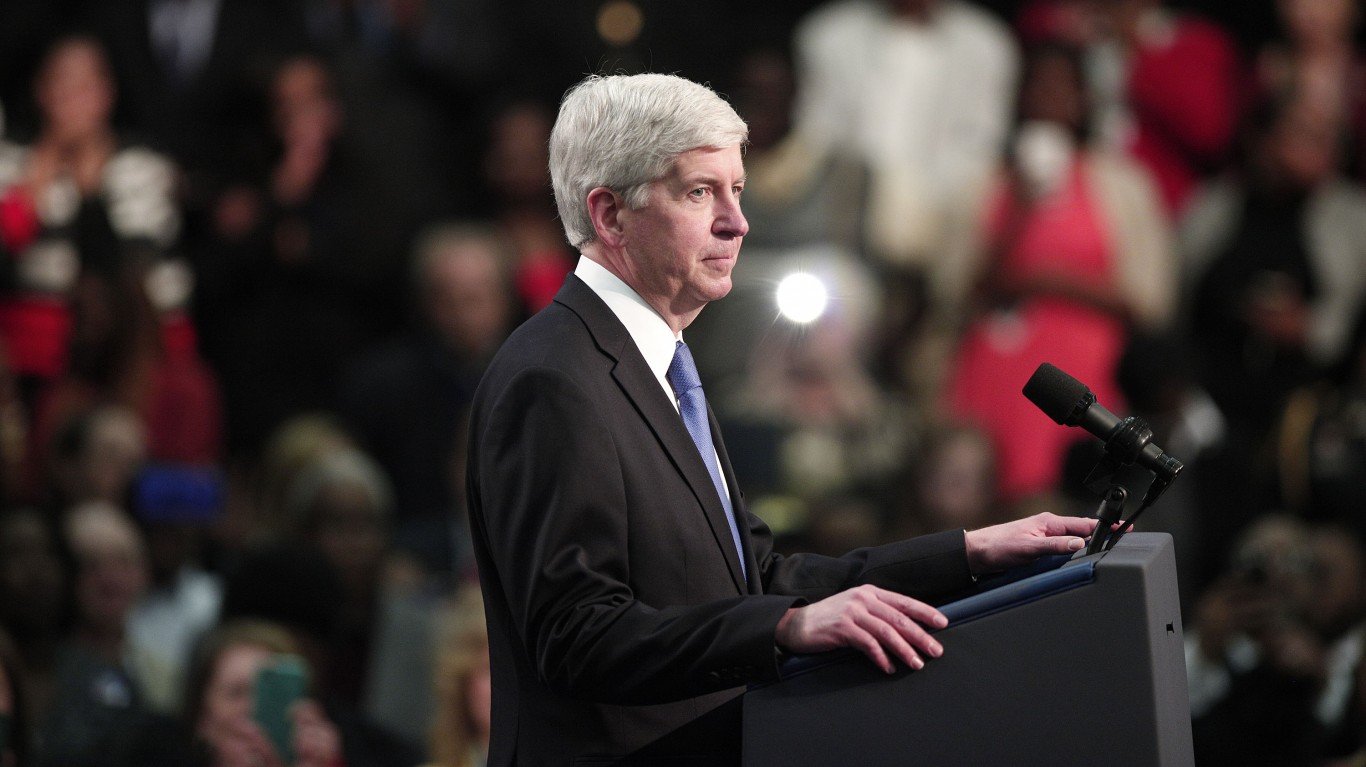
45. Gov. Rick Snyder (R) of Michigan
> Approval rating: 35%
> Disapproval rating: 50%
> Tenure: 8 years
> Nov. 2018 state unemployment: 3.9% (21st highest)
First inaugurated in January 2011, Rick Snyder served as governor of Michigan for two terms, the maximum allowed by law. Democrat Gretchen Whitmer took the top job in January 2019 after defeating Republican Bill Schuette in the general election.
[in-text-ad]

44. Gov. Susana Martinez (R) of New Mexico
> Approval rating: 36%
> Disapproval rating: 54%
> Tenure: 8 years
> Nov. 2018 state unemployment: 4.6% (7th highest)
Susana Martinez will finish her second term as governor of New Mexico in January 2019, being ineligible to run for a third consecutive term under New Mexico law. Democrat Michelle Lujan Grisham will take the top job after defeating Republican Steve Pearce by 14.2 points in the general election.
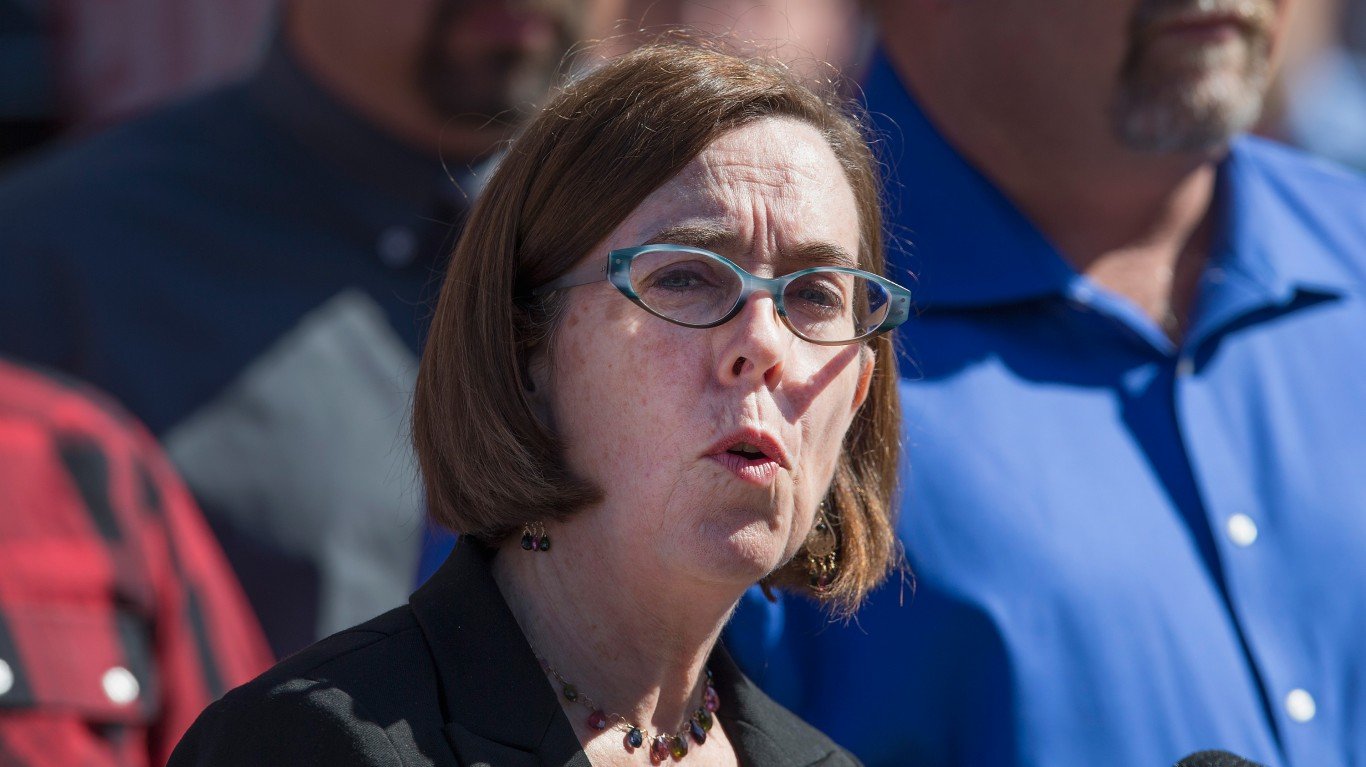
43. Gov. Kate Brown (D) of Oregon
> Approval rating: 39%
> Disapproval rating: 46%
> Tenure: 4 years
> Nov. 2018 state unemployment: 3.9% (21st highest)
Despite a 39% approval rating, Oregon governor Kate Brown defeated Republican challenger Knute Buehler in the 2018 general election and will remain governor for a second term.
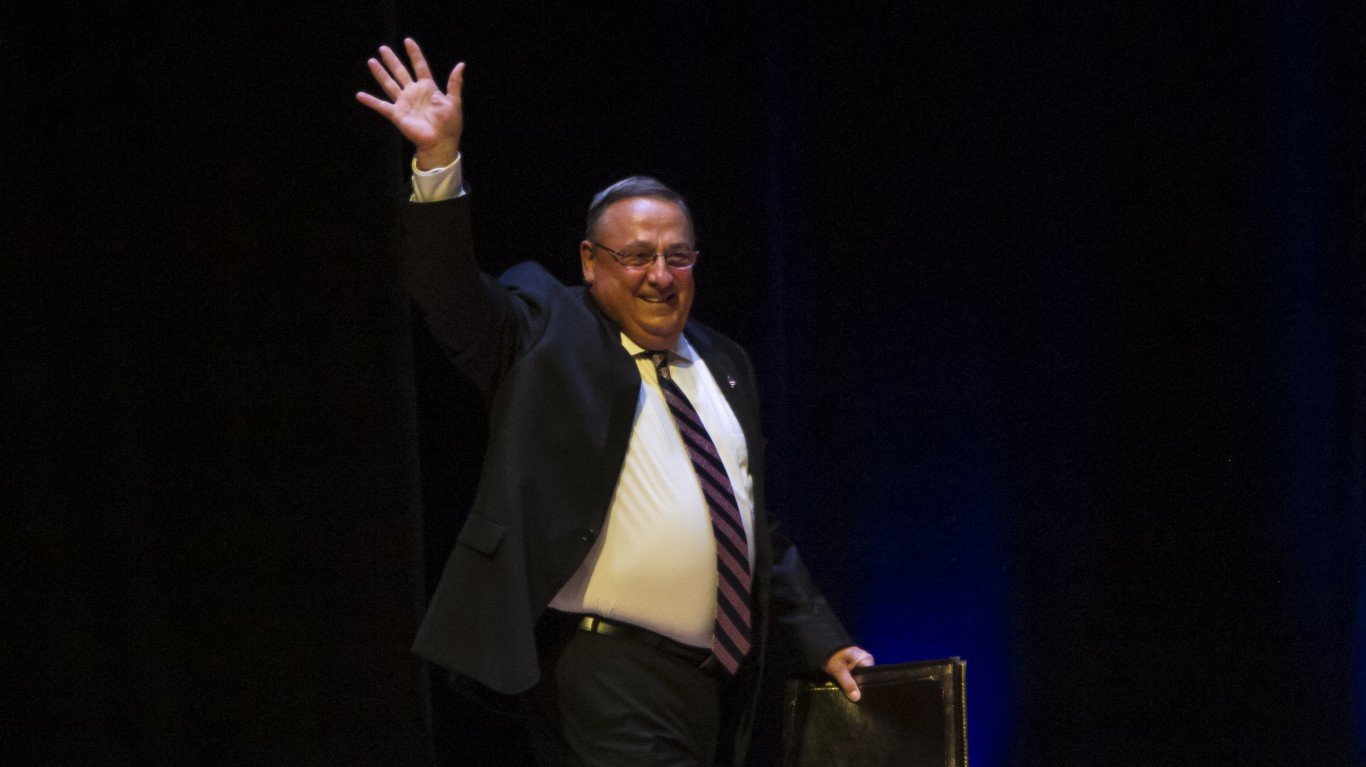
42. Gov. Paul LePage (R) of Maine
> Approval rating: 40%
> Disapproval rating: 54%
> Tenure: 8 years
> Nov. 2018 state unemployment: 3.4% (19th lowest)
Paul LePage was not eligible to run for re-election in 2018 after serving two consecutive terms as governor of Maine. Democrat Janet Mills took the top job LePage held for eight years in January 2019.
[in-text-ad-2]

41. Gov. Jeff Colyer (R) of Kansas
> Approval rating: 40%
> Disapproval rating: 30%
> Tenure: 1 year
> Nov. 2018 state unemployment: 3.2% (13th lowest)
Former Lieutenant Governor of Kansas, Jeff Colyer, took the top job in January 2018 when then Gov. Sam Brownback accepted an ambassadorship in the Trump administration. Up for re-election the same year he took office, Colyer narrowly lost the Republican primary to Kris Kobach, who lost the general election to Democrat Laura Kelly. Kelly will be inaugurated in January 2019.
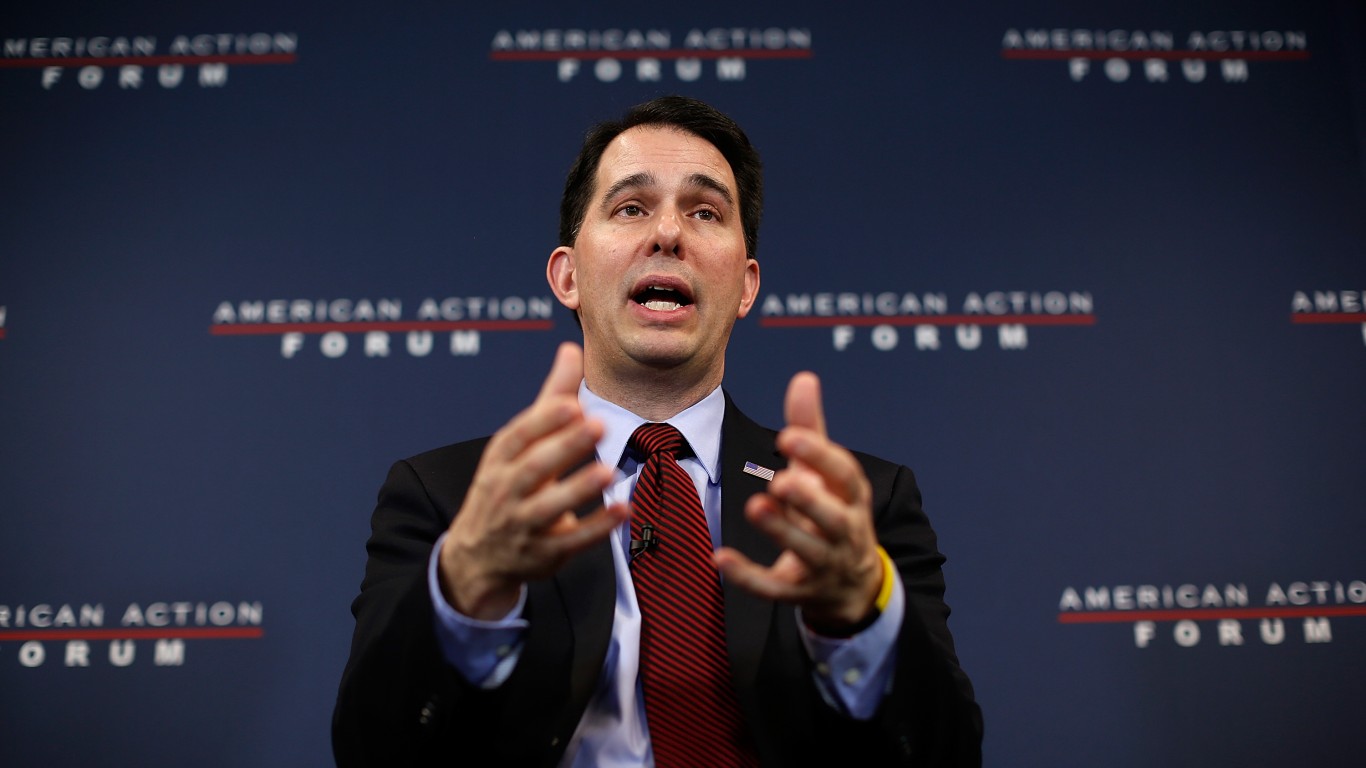
40. Gov. Scott Walker (R) of Wisconsin
> Approval rating: 42%
> Disapproval rating: 50%
> Tenure: 8 years
> Nov. 2018 state unemployment: 3.0% (10th lowest)
Republican Scott Walker served as governor of Wisconsin for eight years. Walker had a 42% approval rating going into the 2018 general election, which he lost by a slim margin to Democratic challenger Tony Evers.
[in-text-ad]
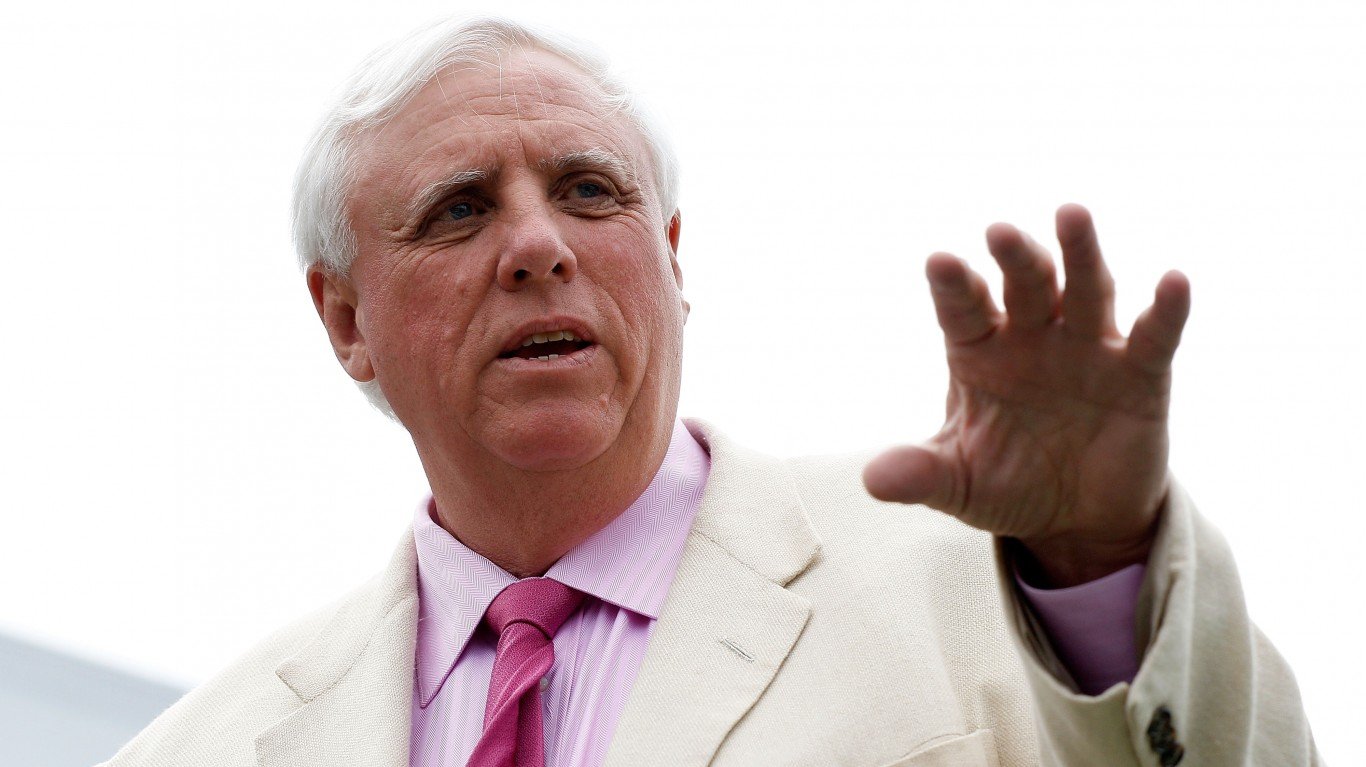
39. Gov. Jim Justice (R) of West Virginia
> Approval rating: 43%
> Disapproval rating: 43%
> Tenure: 2 years
> Nov. 2018 state unemployment: 5.2% (2nd highest)
Jim Justice, the polarizing Republican governor of West Virginia, ran for office and won as Democrat in 2016. About half a year into his first term, Justice re-registered as a Republican. Justice is up for re-election in 2020.
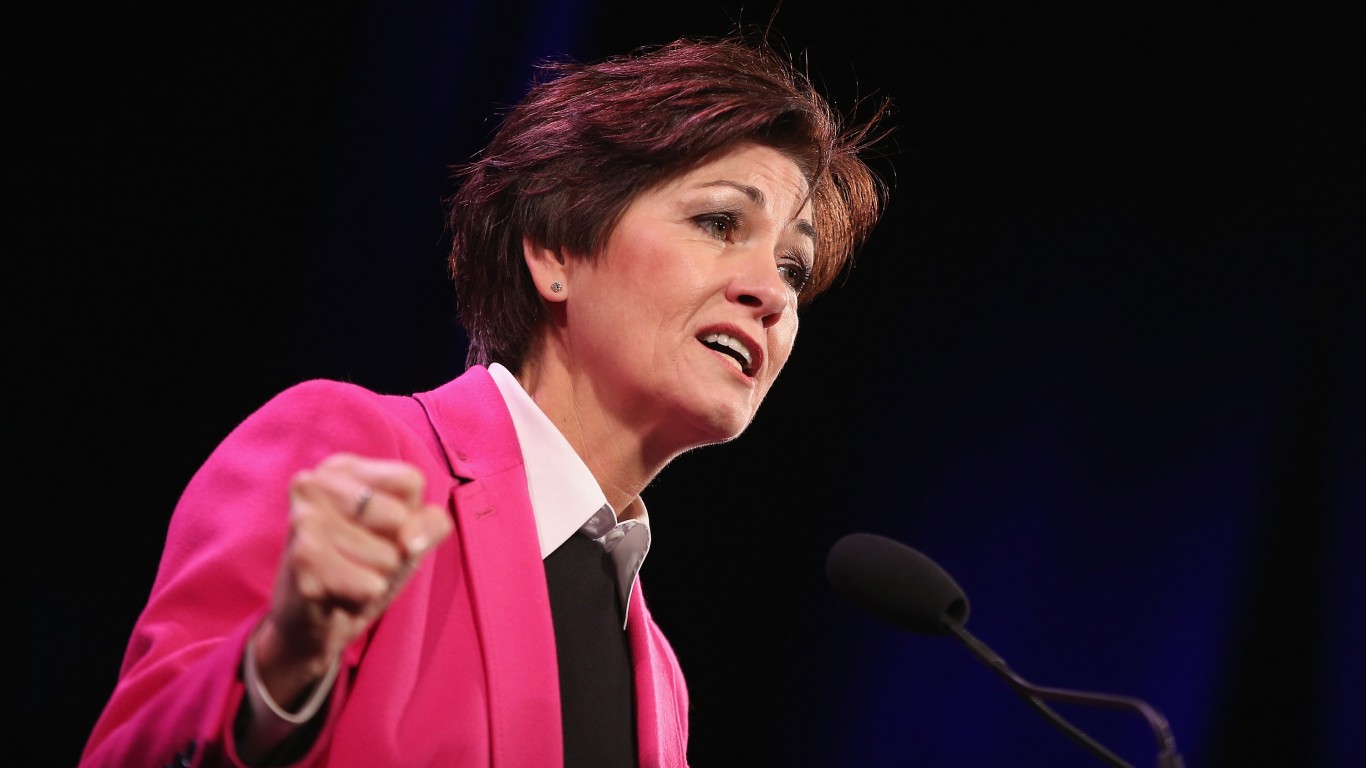
38. Gov. Kim Reynolds (R) of Iowa
> Approval rating: 43%
> Disapproval rating: 38%
> Tenure: 2 years
> Nov. 2018 state unemployment: 2.4% (the lowest)
Republican Kim Reynolds served as the lieutenant governor of Iowa for about six years before taking the top job in May 2017, when former Gov. Terry Branstad took an ambassadorship in the Trump administration. Reynolds ran for governor in 2018 and defeated Democratic challenger Fred Hubbell.

37. Gov. Mike Parson (R) of Missouri
> Approval rating: 43%
> Disapproval rating: 17%
> Tenure: > 1 year
> Nov. 2018 state unemployment: 3.0% (10th lowest)
Elected as lieutenant governor in 2016, Mike Parson took the top job after former Gov. Eric Greitens resigned in mid-2018 amid sexual misconduct allegations and investigations into misuse of voter data. Parson has a 43% approval rating but a sizable 41% of Missouri voters do not have a strong opinion about him yet.
[in-text-ad-2]
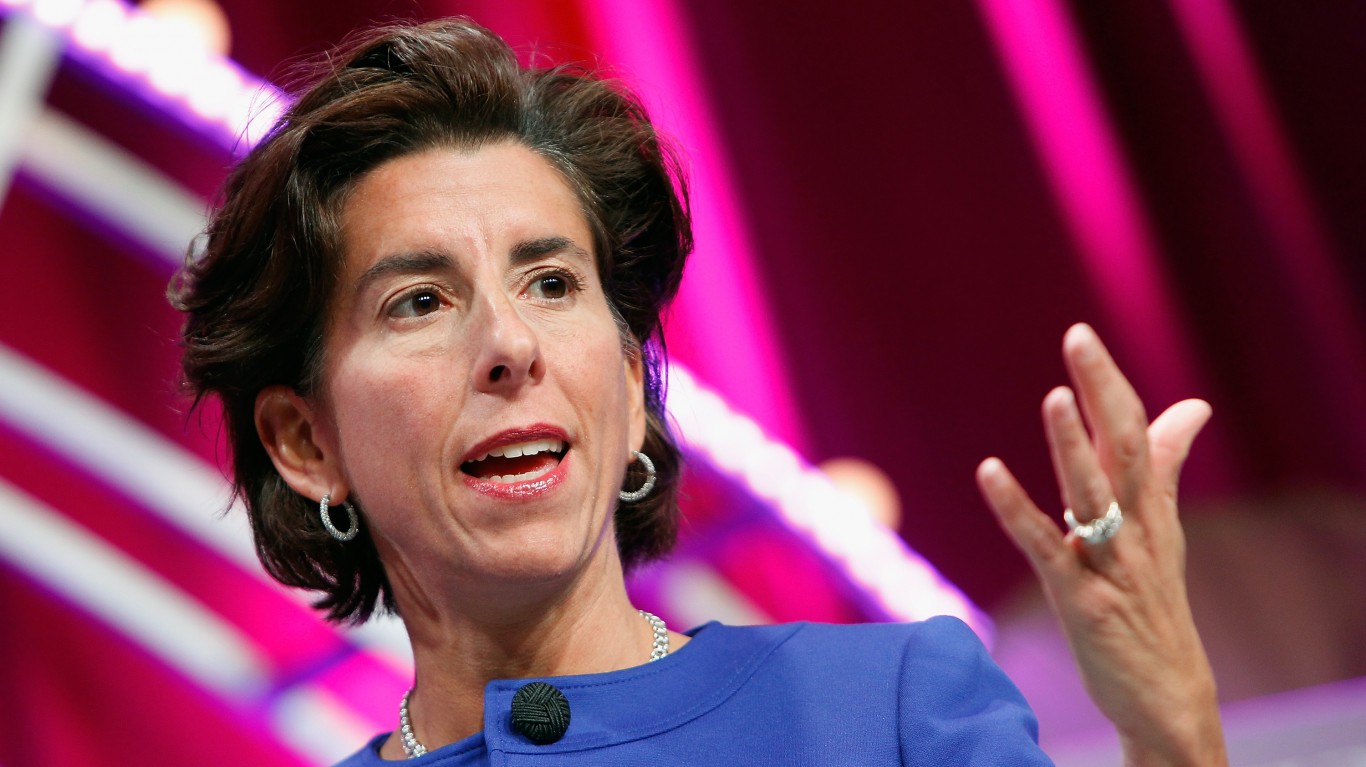
36. Gov. Gina Raimondo (D) of Rhode Island
> Approval rating: 44%
> Disapproval rating: 47%
> Tenure: 4 years
> Nov. 2018 state unemployment: 3.8% (23rd highest)
After defeating Republican challenger Allan Fung in the November 2018 election, Gov. Gina Raimondo will be sworn in to a second term in January 2019. Raimondo won by a 15.3 margin despite a high disapproval rating.

35. Gov. Jerry Brown (D) of California
> Approval rating: 44%
> Disapproval rating: 41%
> Tenure: 8 years
> Nov. 2018 state unemployment: 4.1% (15th highest)
Democrat Jerry Brown stepped down as governor of California in January 2019 after serving the state for two consecutive four-year terms, the maximum allowed by law. Brown also served as governor of California from 1975 to 1983.
[in-text-ad]
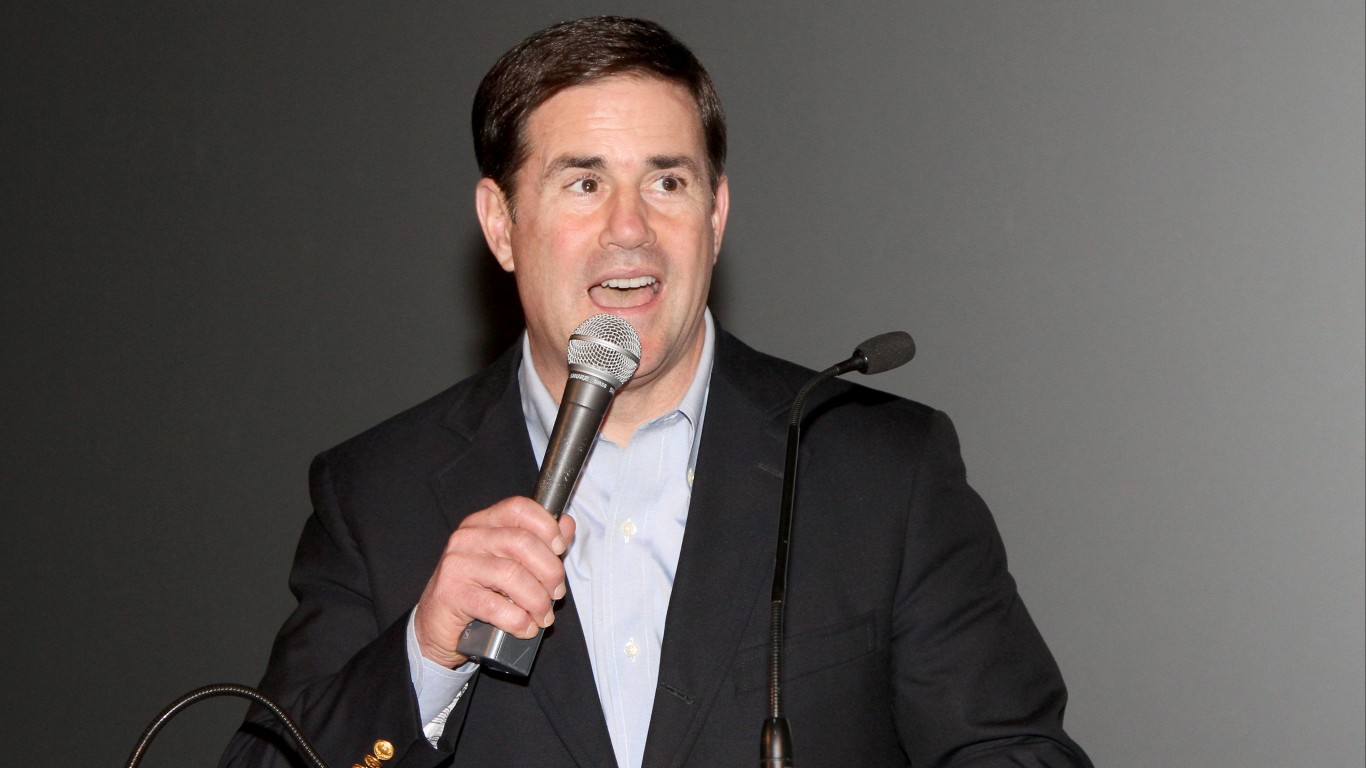
34. Gov. Doug Ducey (R) of Arizona
> Approval rating: 45%
> Disapproval rating: 38%
> Tenure: 4 years
> Nov. 2018 state unemployment: 4.7% (5th highest)
Sworn in for the first time in January 2015, Republican Doug Ducey ran for re-election in 2018 and defeated Democratic challenger David Garcia. Ducey will not be eligible to run for a third term in 2022 as Arizona governors are limited to two consecutive terms.
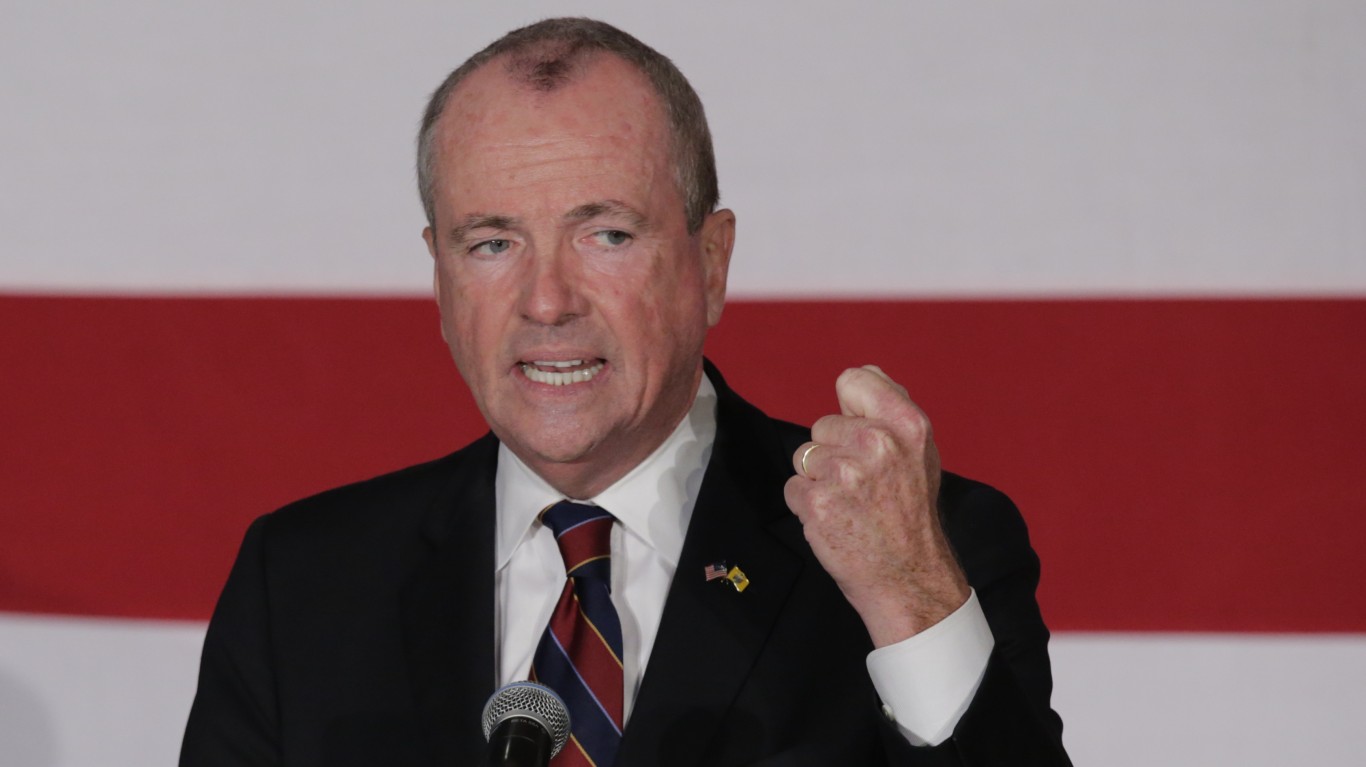
33. Gov. Phil Murphy (D) of New Jersey
> Approval rating: 45%
> Disapproval rating: 35%
> Tenure: 1 year
> Nov. 2018 state unemployment: 4.0% (18th highest)
Democrat Phil Murphy was elected governor of New Jersey in November 2017 and took office in January 2018. Murphy’s first term follows that of term-limited Republican Chris Christie, who departed as the least popular governor in the country with a 19% approval rating.
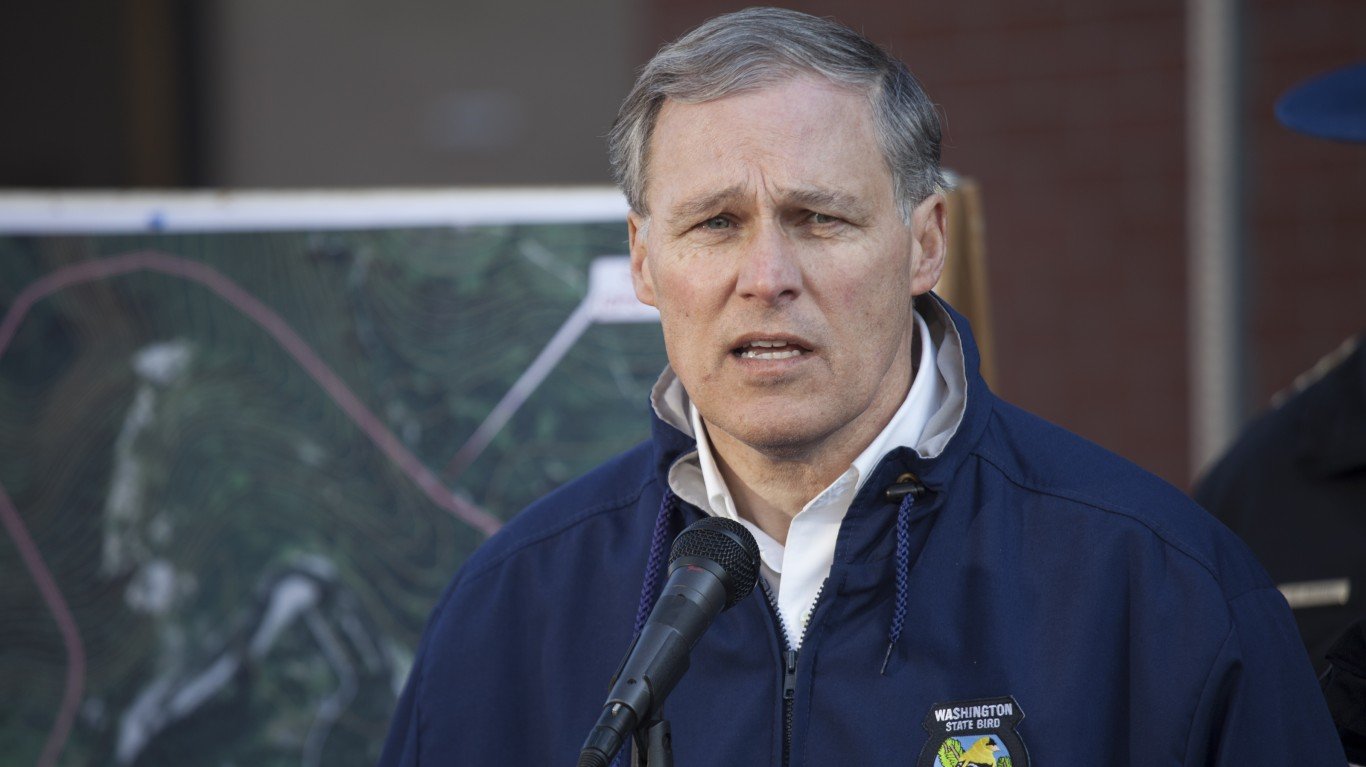
32. Gov. Jay Inslee (D) of Washington
> Approval rating: 46%
> Disapproval rating: 33%
> Tenure: 6 years
> Nov. 2018 state unemployment: 4.3% (10th highest)
Washington Gov. Jay Inslee is in the middle of his second term after he ran for re-election in November 2016. Though Washington does not impose term limits on its governors, Inslee may not seek a third term as he is currently considering a bid for the presidency.
[in-text-ad-2]
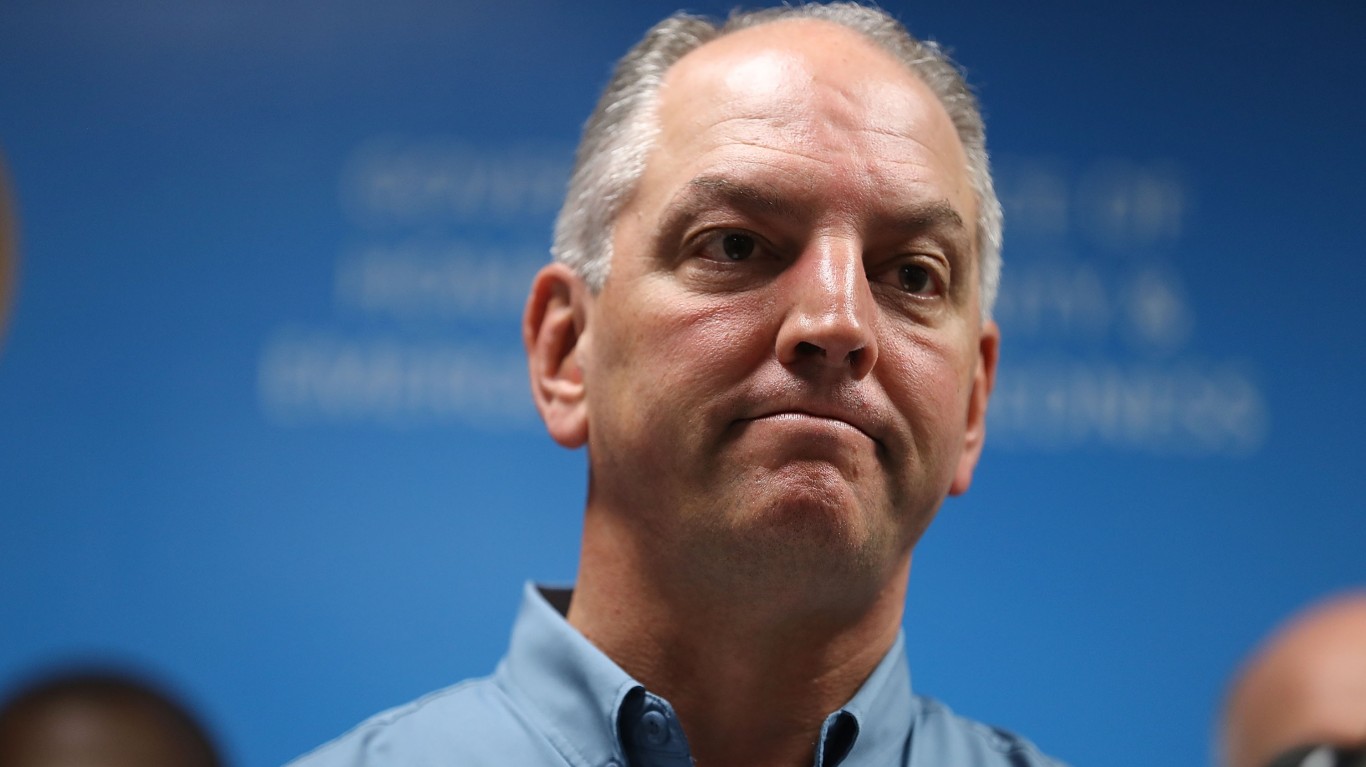
31. Gov. John Bel Edwards (D) of Louisiana
> Approval rating: 47%
> Disapproval rating: 34%
> Tenure: 3 years
> Nov. 2018 state unemployment: 5.0% (3rd highest)
Democrat John Bel Edwards has served as governor of Louisiana since his swearing in January 2016. Edwards is up for re-election this year.
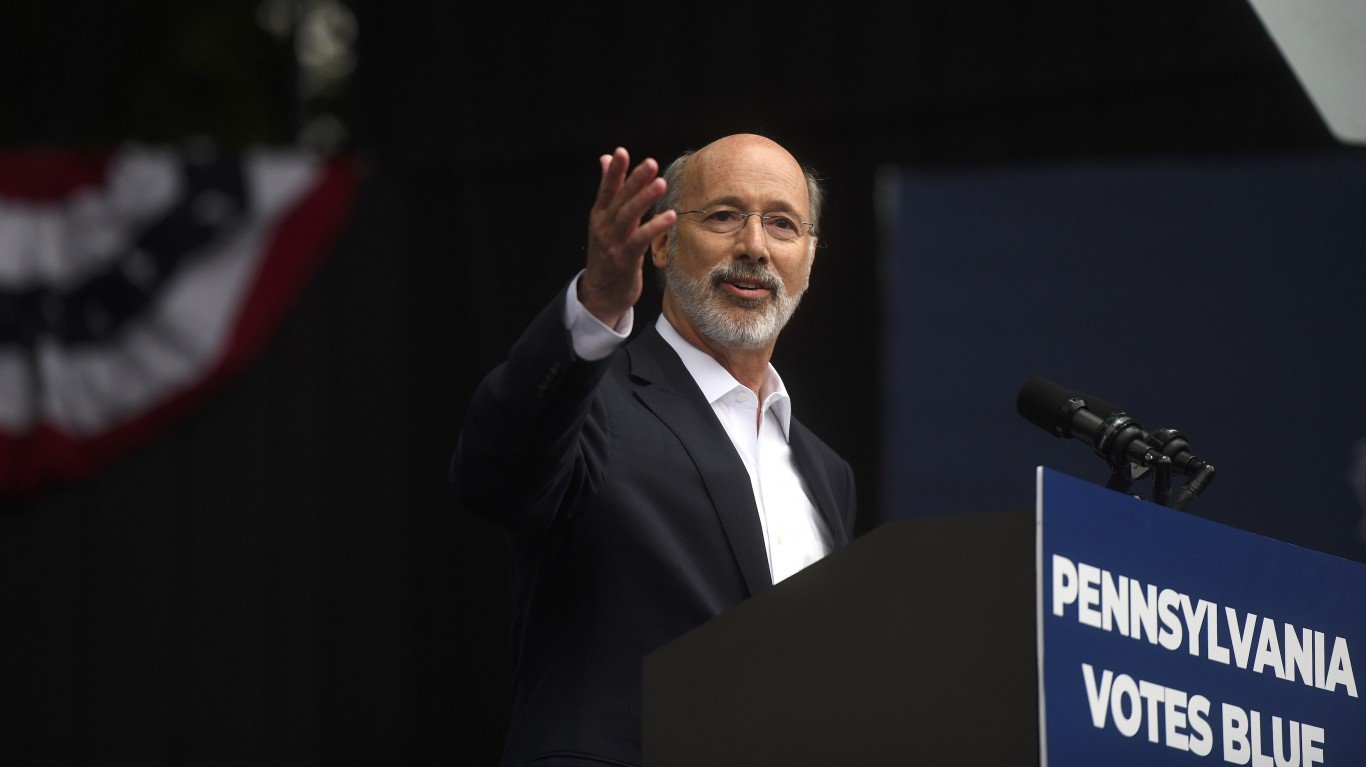
30. Gov. Tom Wolf (D) of Pennsylvania
> Approval rating: 48%
> Disapproval rating: 36%
> Tenure: 4 years
> Nov. 2018 state unemployment: 4.2% (12th highest)
Defeating Republican challenger Scott Wagner in the 2018 general election, Democrat Tom Wolf has served as governor of Pennsylvania since his first inauguration on 2015. Wolf will not be eligible to run again in 2022 as Pennsylvania governors are limited to two consecutive terms.
[in-text-ad]
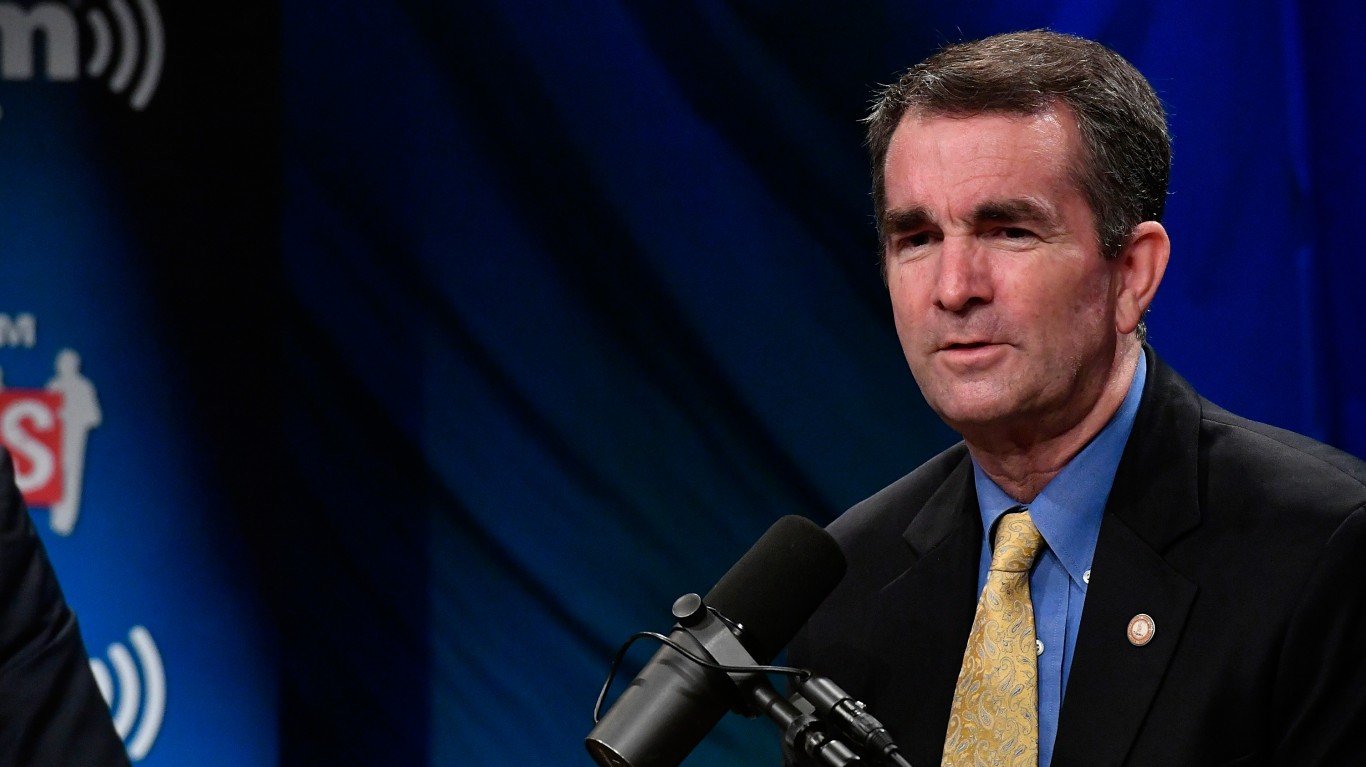
29. Gov. Ralph Northam (D) of Virginia
> Approval rating: 48%
> Disapproval rating: 26%
> Tenure: 1 year
> Nov. 2018 state unemployment: 2.8% (6th lowest)
Democrat Ralph Northam was elected governor of Virginia in 2017, after serving as the state’s lieutenant governor for four years.
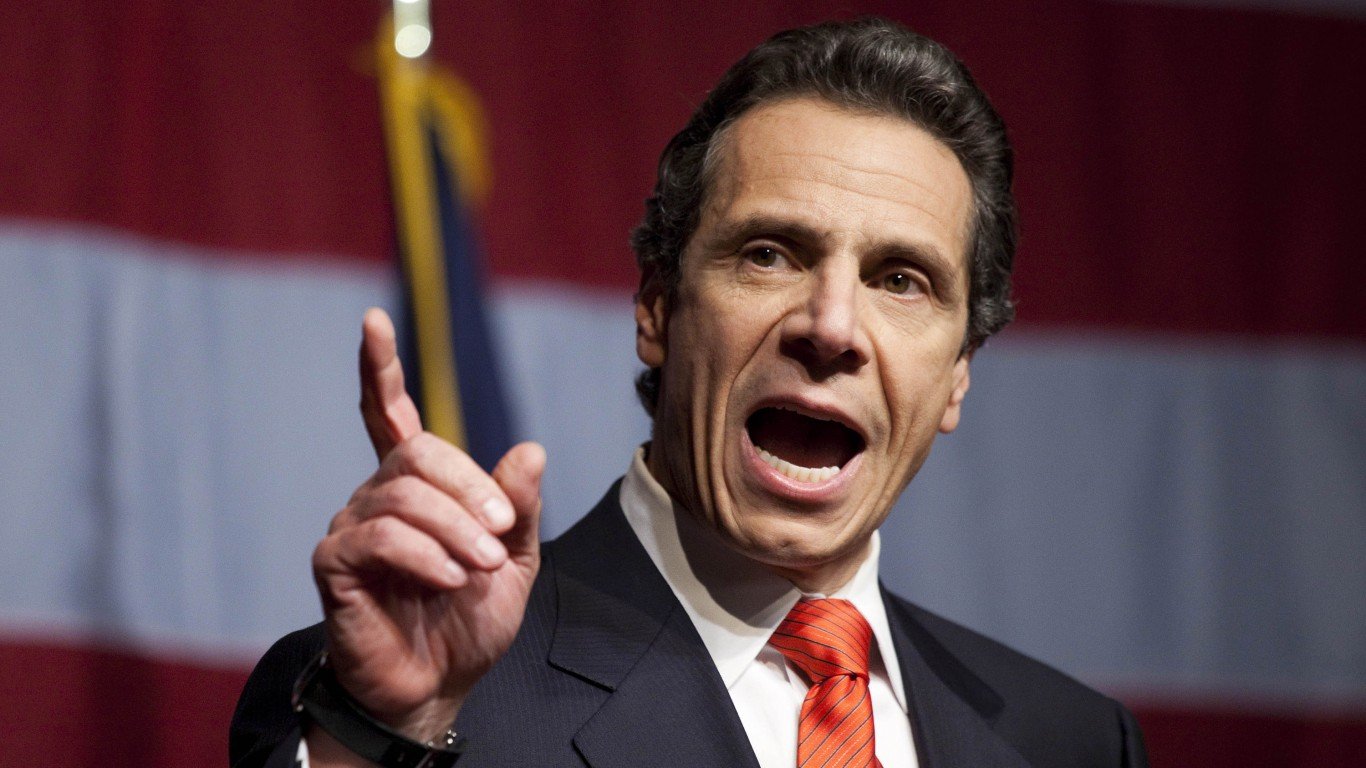
28. Gov. Andrew Cuomo (D) of New York
> Approval rating: 49%
> Disapproval rating: 40%
> Tenure: 8 years
> Nov. 2018 state unemployment: 3.9% (21st highest)
After serving as New York’s governor for eight years, Democrat Andrew Cuomo defeated Republican challenger Marcus Molinaro in the November 2018 general election. New York has no term limits for governors, and Cuomo was sworn in for a third time in January 2019.

27. Gov. Rick Scott (R) of Florida
> Approval rating: 49%
> Disapproval rating: 40%
> Tenure: 8 years
> Nov. 2018 state unemployment: 3.3% (15th lowest)
Republican Rick Scott served as governor of Florida for two consecutive terms, the maximum allowed by state law. Barred from running for a third term, Scott ran for the U.S. Senate, winning in November 2018 by a narrow margin. Scott left the Florida governor’s office in January 2019.
[in-text-ad-2]

26. Gov. Mark Dayton (D) of Minnesota
> Approval rating: 49%
> Disapproval rating: 37%
> Tenure: 8 years
> Nov. 2018 state unemployment: 2.8% (6th lowest)
Democrat Mark Dayton served as the governor of Minnesota for eight years, stepping down in January 2019 after deciding not to seek a third term.
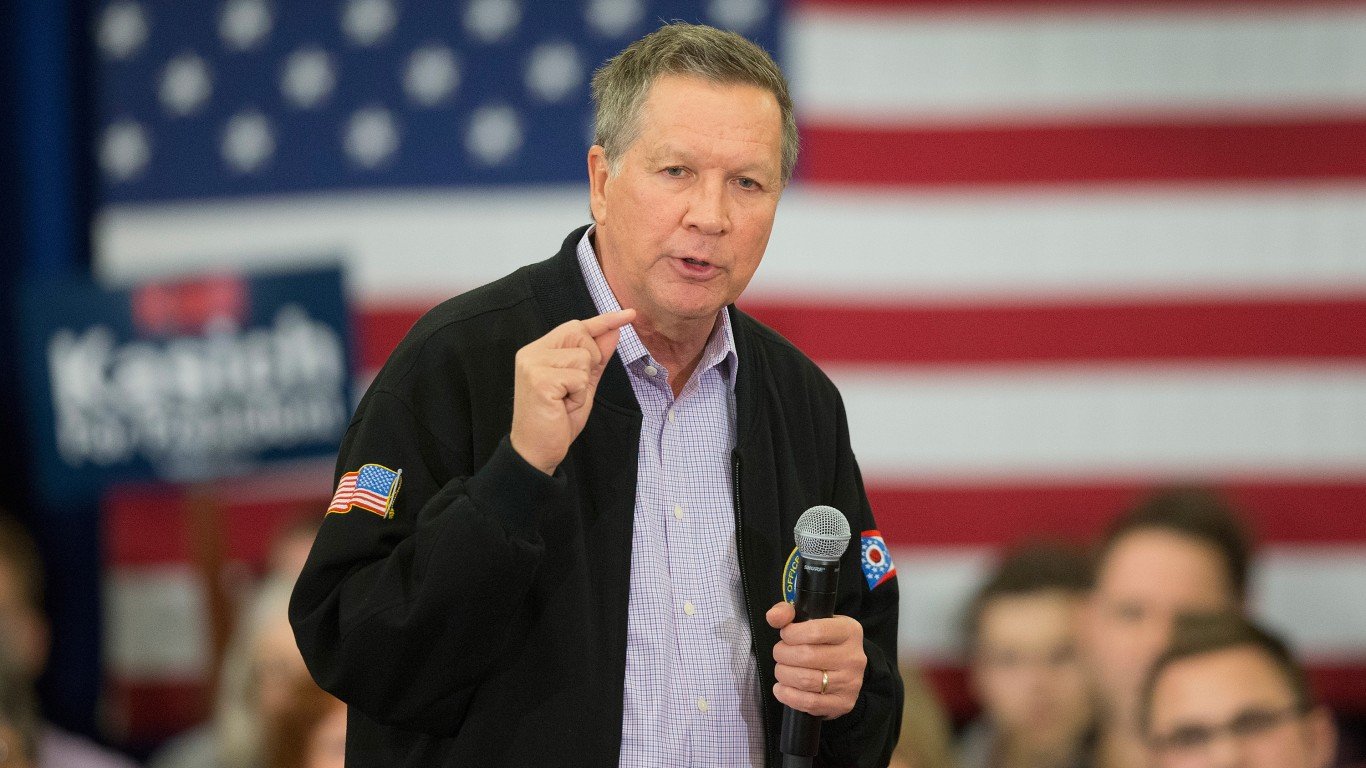
25. Gov. John Kasich (R) of Ohio
> Approval rating: 49%
> Disapproval rating: 32%
> Tenure: 8 years
> Nov. 2018 state unemployment: 4.6% (7th highest)
Republican John Kasich was elected governor of Ohio twice, first in 2010 and again 2014. He was barred by state law from seeking a third term. Republican Mike DeWine will become governor in January 2019 after defeating Democrat Richard Cordray in the November elections.
[in-text-ad]
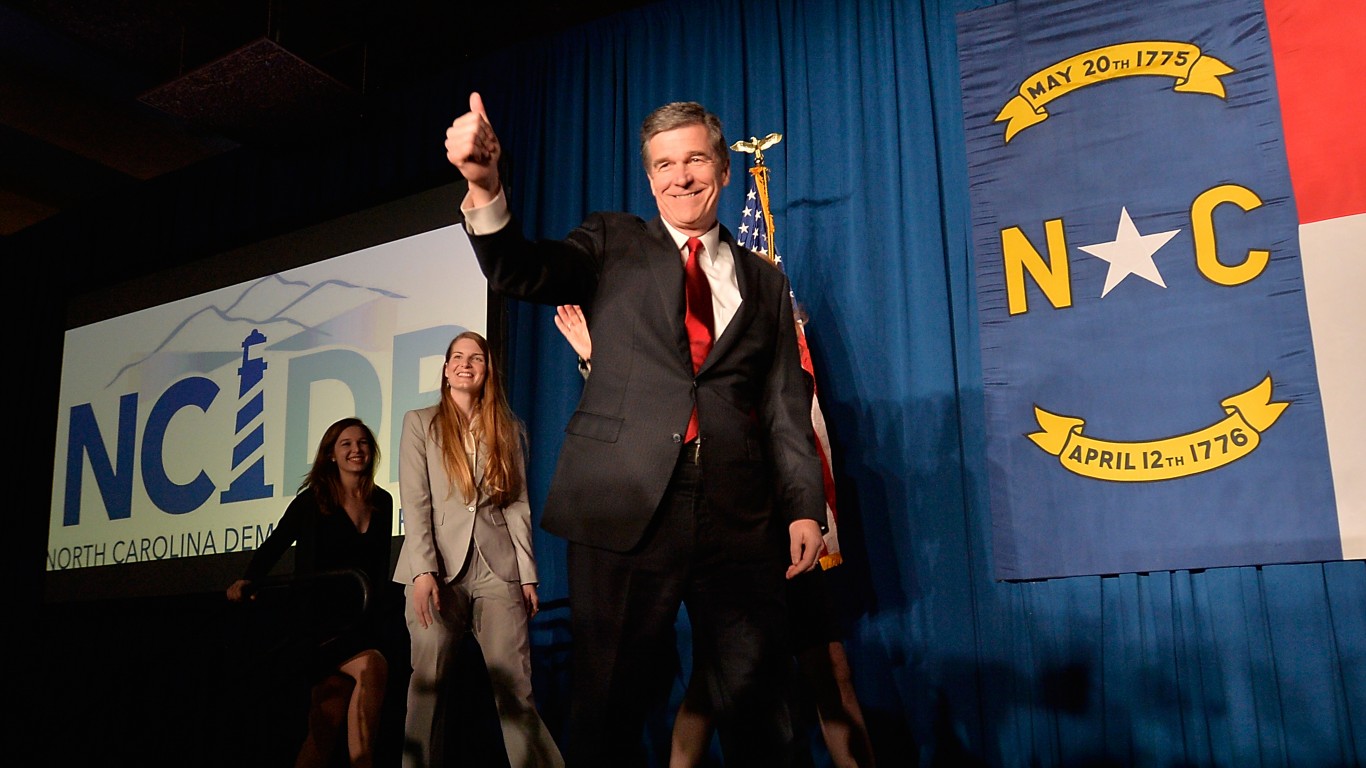
24. Gov. Roy Cooper (D) of North Carolina
> Approval rating: 49%
> Disapproval rating: 29%
> Tenure: 2 years
> Nov. 2018 state unemployment: 3.6% (22nd lowest)
Democrat Roy Cooper took office in January 2017, after narrowly defeating incumbent Gov. Pat McCrory in the November 2016 general election. Cooper is up for re-election in 2020.
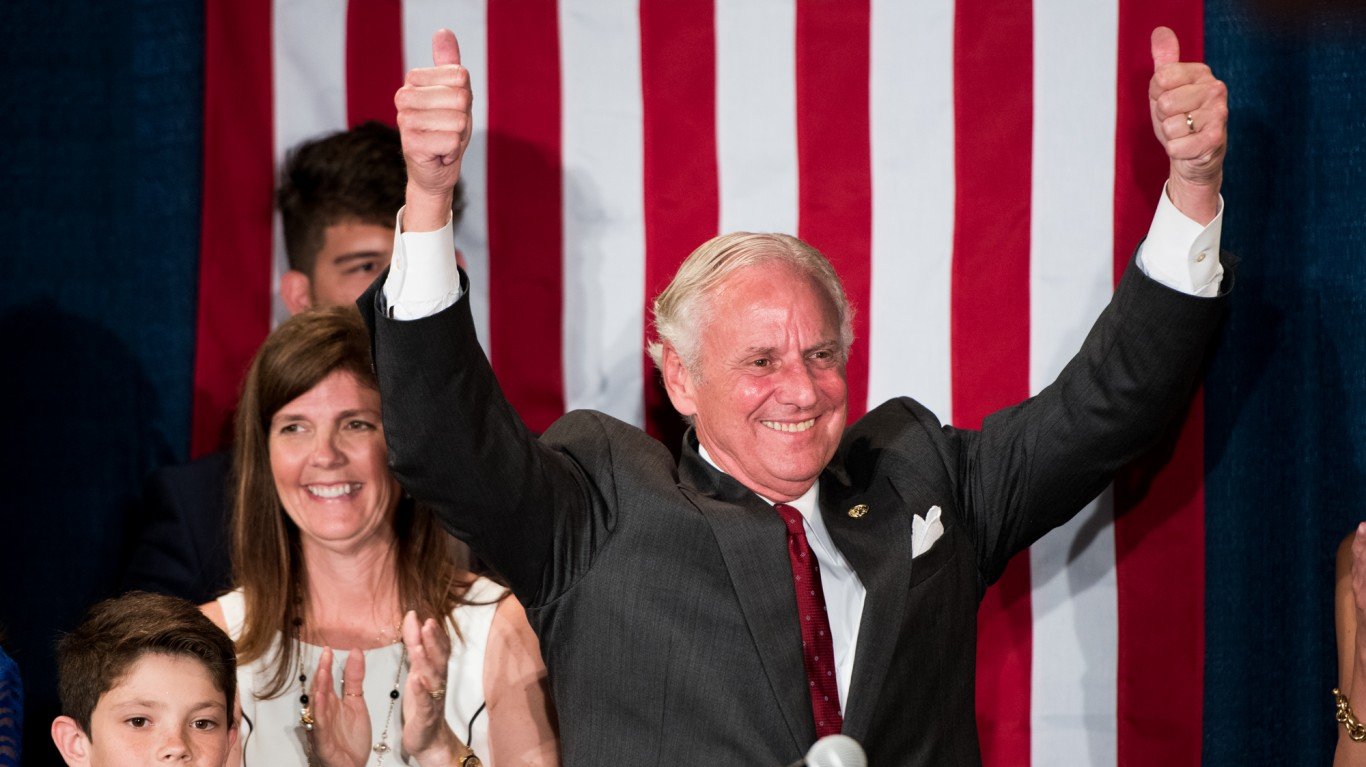
23. Gov. Henry McMaster (R) of South Carolina
> Approval rating: 49%
> Disapproval rating: 29%
> Tenure: 2 years
> Nov. 2018 state unemployment: 3.3% (15th lowest)
Republican Henry McMaster was elected lieutenant governor of South Carolina in 2014 and took the top job when former Gov. Nikki Haley was confirmed as U.S. ambassador to the United Nations in January 2017. In November, McMaster defeated Democratic challenger James Smith. He will be sworn in for a four-year term in January 2019.

22. Gov. Phil Scott (R) of Vermont
> Approval rating: 50%
> Disapproval rating: 38%
> Tenure: 2 years
> Nov. 2018 state unemployment: 2.7% (5th lowest)
In Vermont, governors are up for re-election every two years. First sworn in in January 2017, Republican Phil Scott handily defeated Democratic challenger Christine Hallquist in November 2018.
[in-text-ad-2]
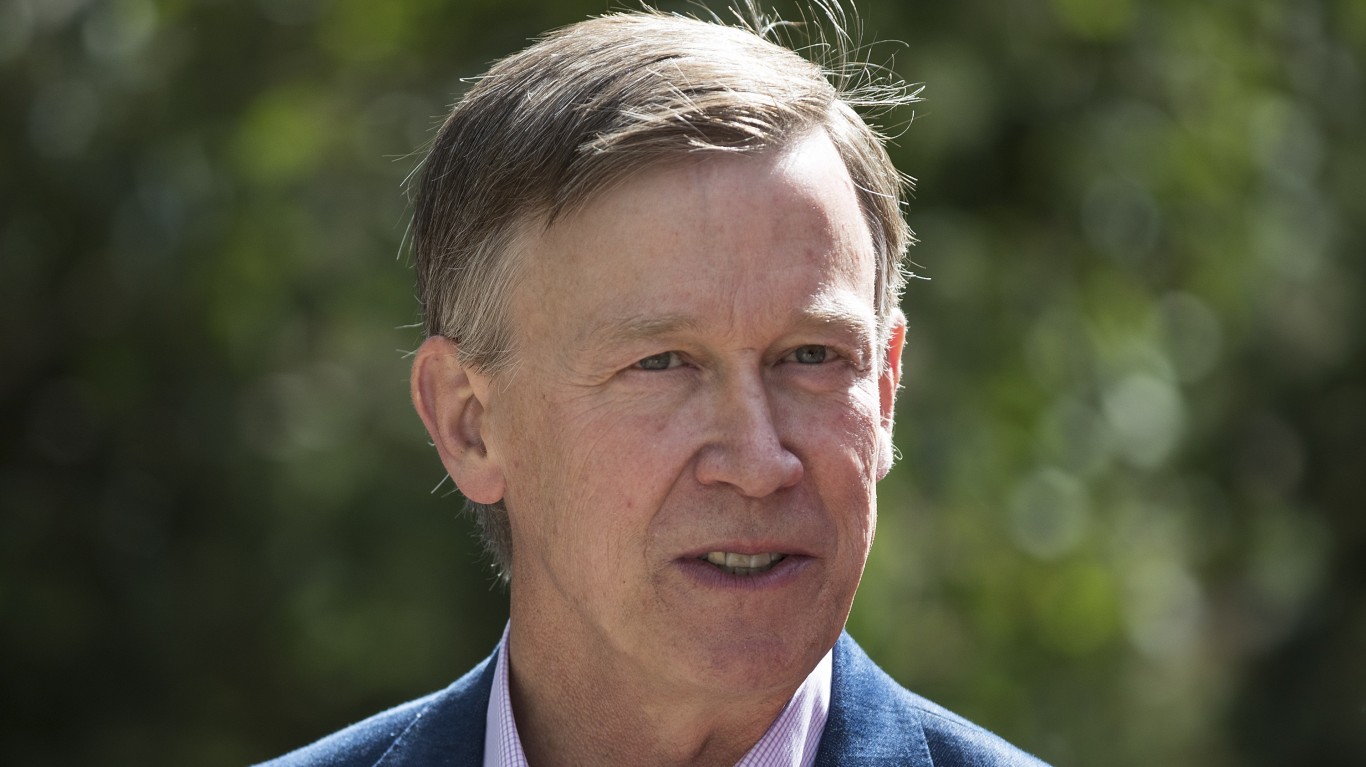
21. Gov. John Hickenlooper (D) of Colorado
> Approval rating: 50%
> Disapproval rating: 32%
> Tenure: 8 years
> Nov. 2018 state unemployment: 3.3% (15th lowest)
Democrat John Hickenlooper served as governor of Colorado for two consecutive terms, the maximum allowed under state law. Democrat Jared Polis took the top job in January 2019 after winning the in the November 2018 elections.
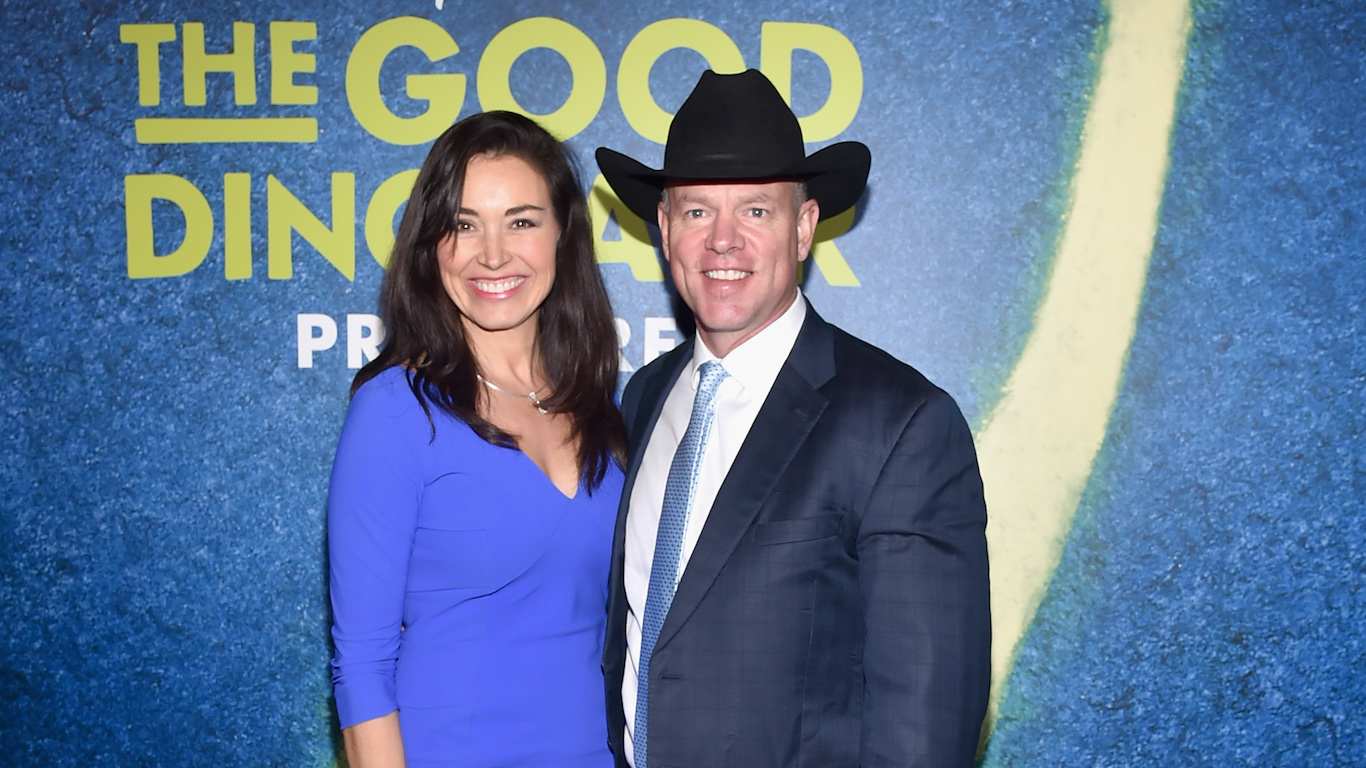
20. Gov. Matt Mead (R) of Wyoming
> Approval rating: 50%
> Disapproval rating: 27%
> Tenure: 8 years
> Nov. 2018 state unemployment: 4.1% (15th highest)
Republican Matt Mead served as governor of Wyoming for two consecutive four-year terms, the maximum allowed under state law. In January 2019, Republican Mark Gordon was sworn in as Wyoming’s new governor.
[in-text-ad]

19. Gov. Eric Holcomb (R) of Indiana
> Approval rating: 50%
> Disapproval rating: 24%
> Tenure: 2 years
> Nov. 2018 state unemployment: 3.6% (22nd lowest)
Eric Holcomb was selected as the Republican gubernatorial nominee in for the 2016 general election, after incumbent candidate Mike Pence withdrew his candidacy when he became Donald Trump’s running mate. Holcomb defeated John Gregg, the Democratic candidate, and will face re-election in 2020.

18. Gov. Butch Otter (R) of Idaho
> Approval rating: 51%
> Disapproval rating: 35%
> Tenure: 12 years
> Nov. 2018 state unemployment: 2.6% (4th lowest)
First elected in November 2006, Republican Butch Otter served as governor of Idaho for 12 years. Otter chose not to run for a fourth term in 2018, and in January 2019, Republican Brad Little took over as governor.
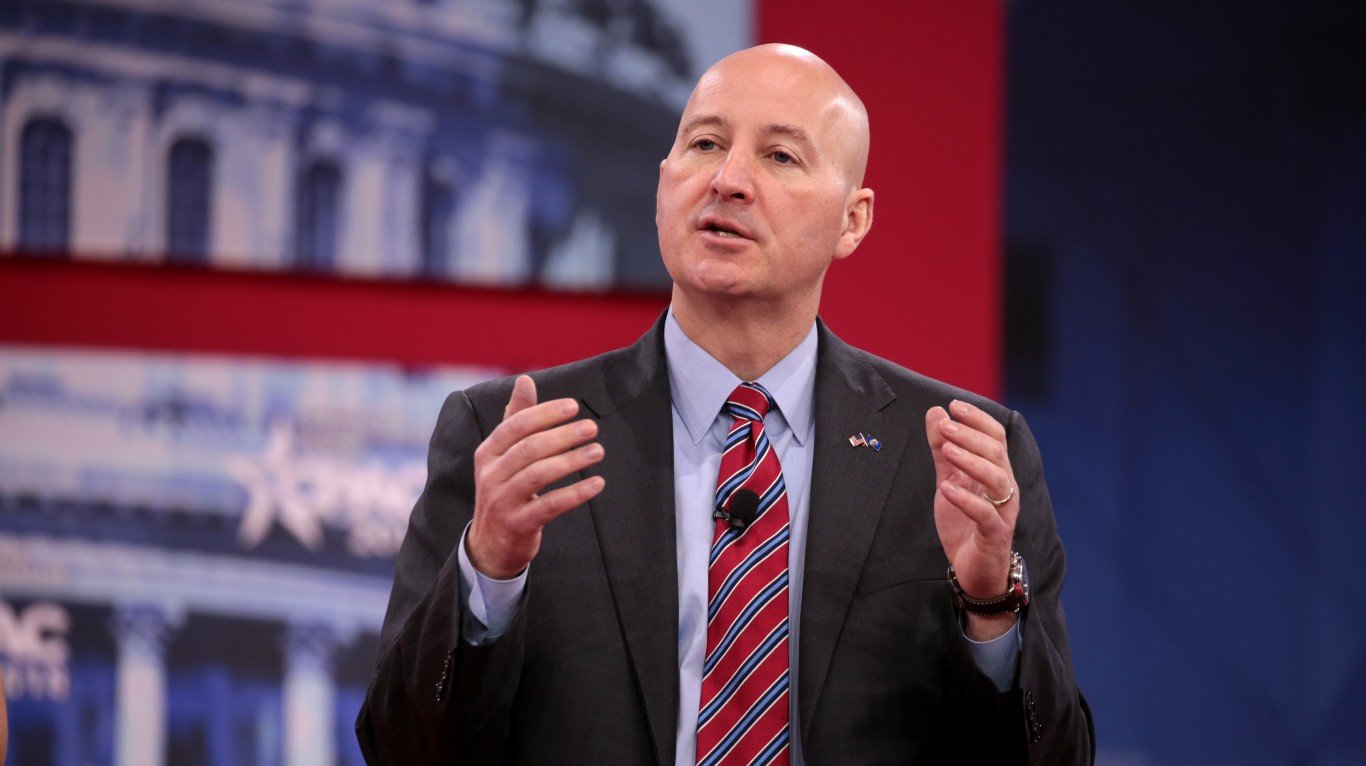
17. Gov. Pete Ricketts (R) of Nebraska
> Approval rating: 51%
> Disapproval rating: 33%
> Tenure: 4 years
> Nov. 2018 state unemployment: 2.8% (6th lowest)
Republican Pete Ricketts took office in January 2015. Ricketts won a bid for re-election against Democrat Bob Krist in November 2018.
[in-text-ad-2]
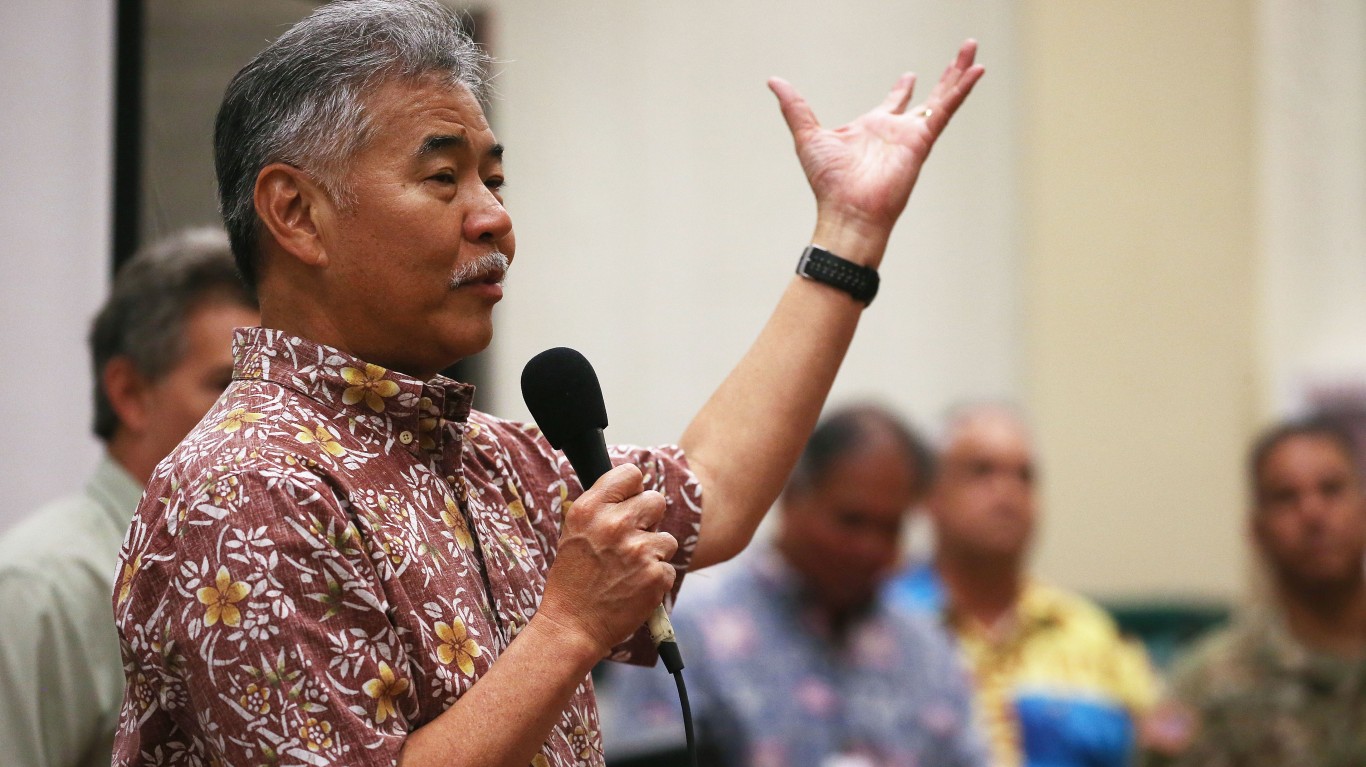
16. Gov. David Ige (D) of Hawaii
> Approval rating: 52%
> Disapproval rating: 39%
> Tenure: 4 years
> Nov. 2018 state unemployment: 2.4% (the lowest)
After serving Hawaii for four years, David Ige was re-elected to the governor’s office in November 2018, defeating Republican challenger Andria Tupola by a wide margin. Ige will be prohibited by state law from running again in 2022.
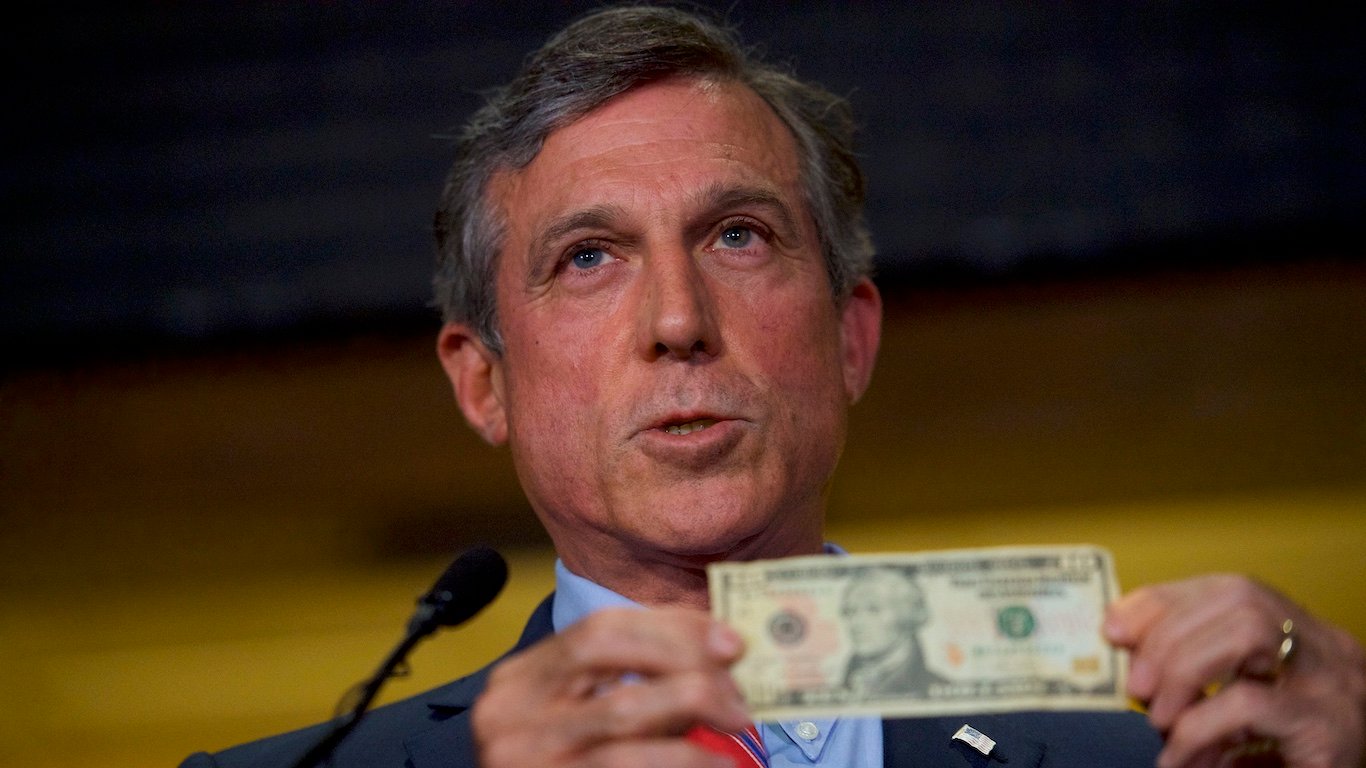
15. Gov. John Carney (D) of Delaware
> Approval rating: 52%
> Disapproval rating: 28%
> Tenure: 2 years
> Nov. 2018 state unemployment: 3.8% (23rd highest)
Democrat John Carney was voted into office in November 2016, handily defeating Republican Colin Bonini in the general election. Carney is up for re-election in 2020.
[in-text-ad]
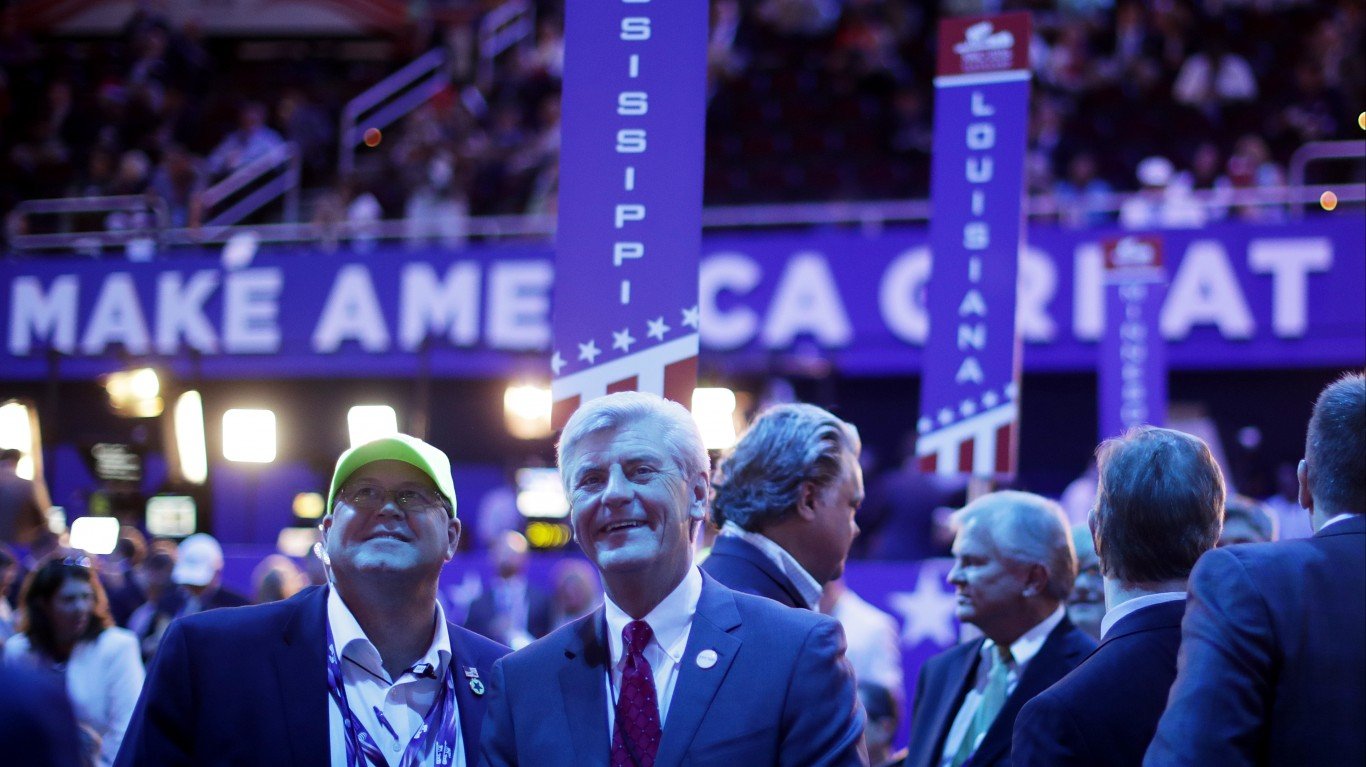
14. Gov. Phil Bryant (R) of Mississippi
> Approval rating: 53%
> Disapproval rating: 25%
> Tenure: 7 years
> Nov. 2018 state unemployment: 4.7% (5th highest)
Republican Phil Bryant was first sworn in as the Governor of Mississippi in January 2012. Re-elected in November 2015, Bryant is prevented by state law from seeking a third term in 2019.
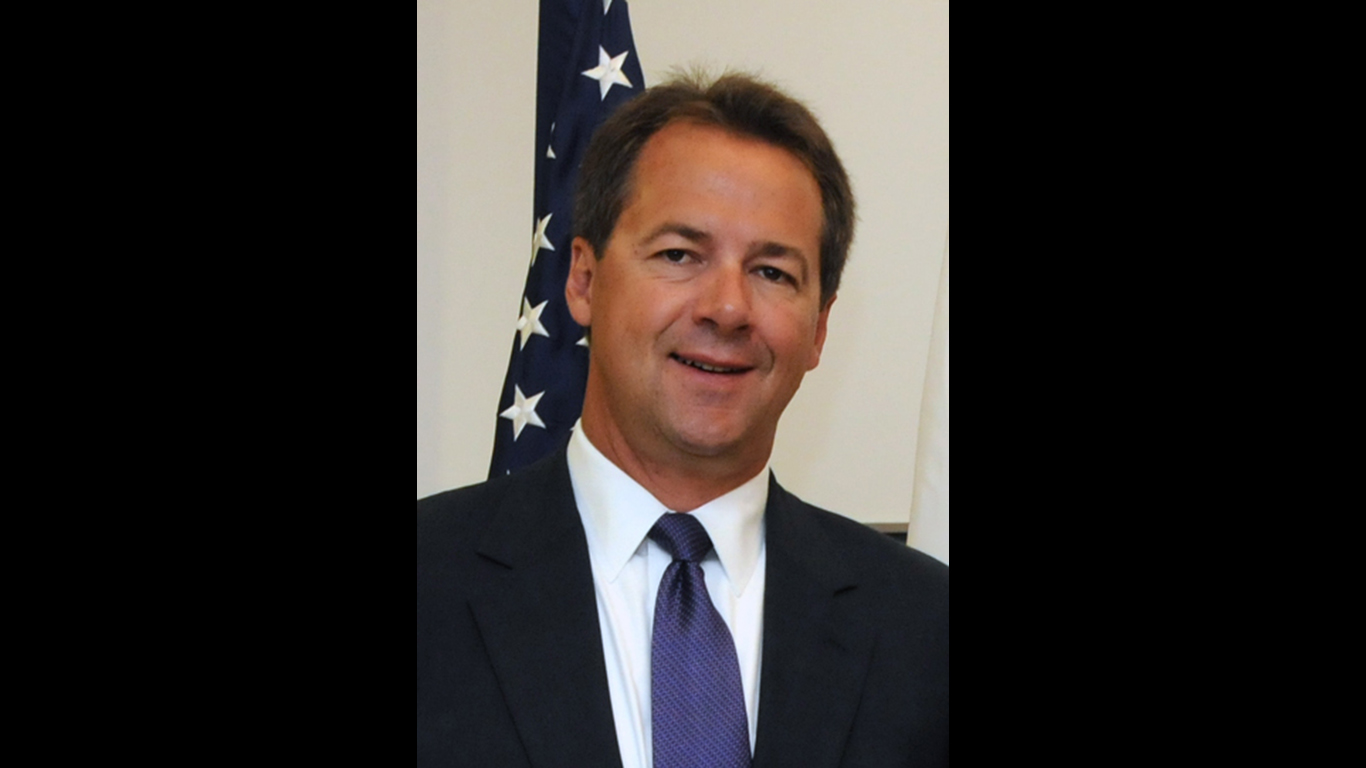
13. Gov. Steve Bullock (D) of Montana
> Approval rating: 54%
> Disapproval rating: 28%
> Tenure: 6 years
> Nov. 2018 state unemployment: 3.7% (25th highest)
Democrat Steve Bullock has served as Montana’s governor since his January 2013 inauguration. Bullock is in the middle of his second term after being re-elected in November 2016.
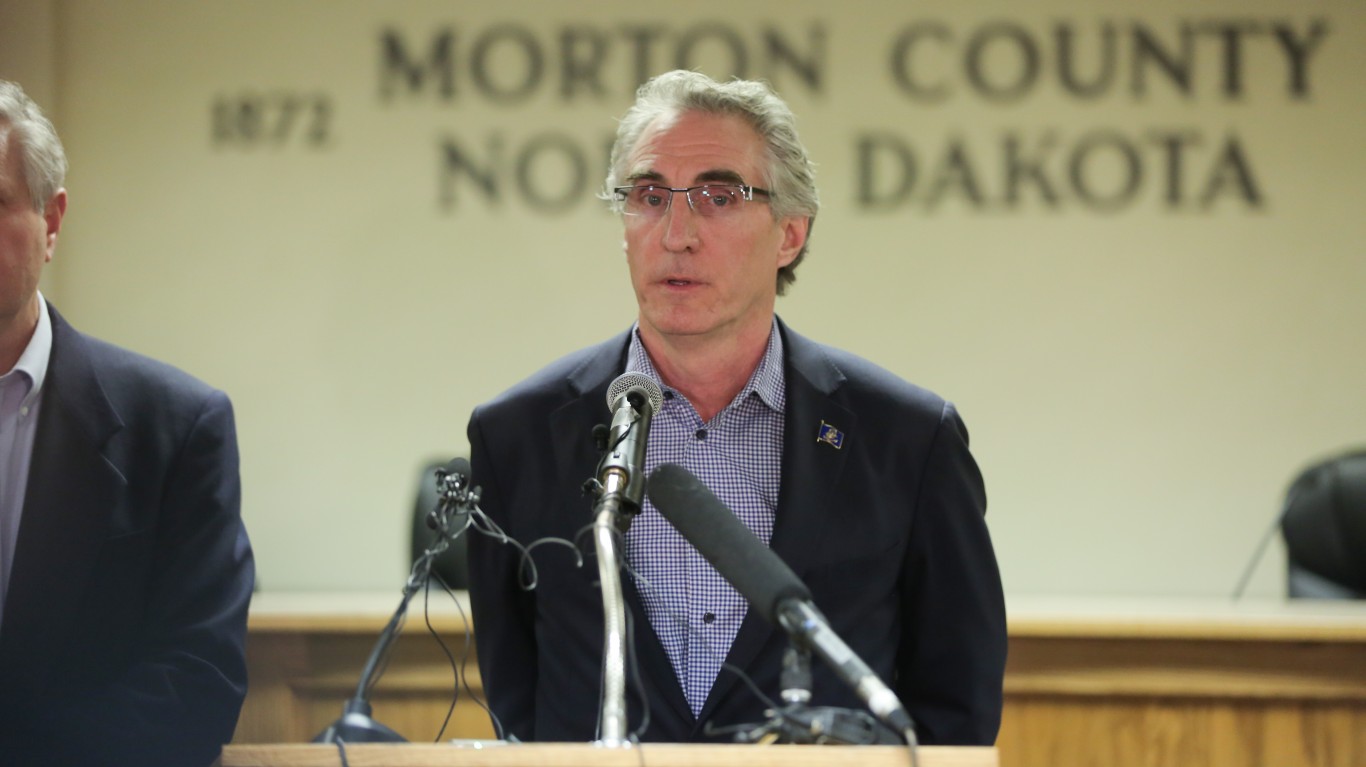
12. Gov. Doug Burgum (R) of North Dakota
> Approval rating: 54%
> Disapproval rating: 25%
> Tenure: 2 years
> Nov. 2018 state unemployment: 2.8% (6th lowest)
Doug Burgum was elected to the governor’s office in November 2016 with over 75% of the vote. Burgum is up for re-election in 2020.
[in-text-ad-2]
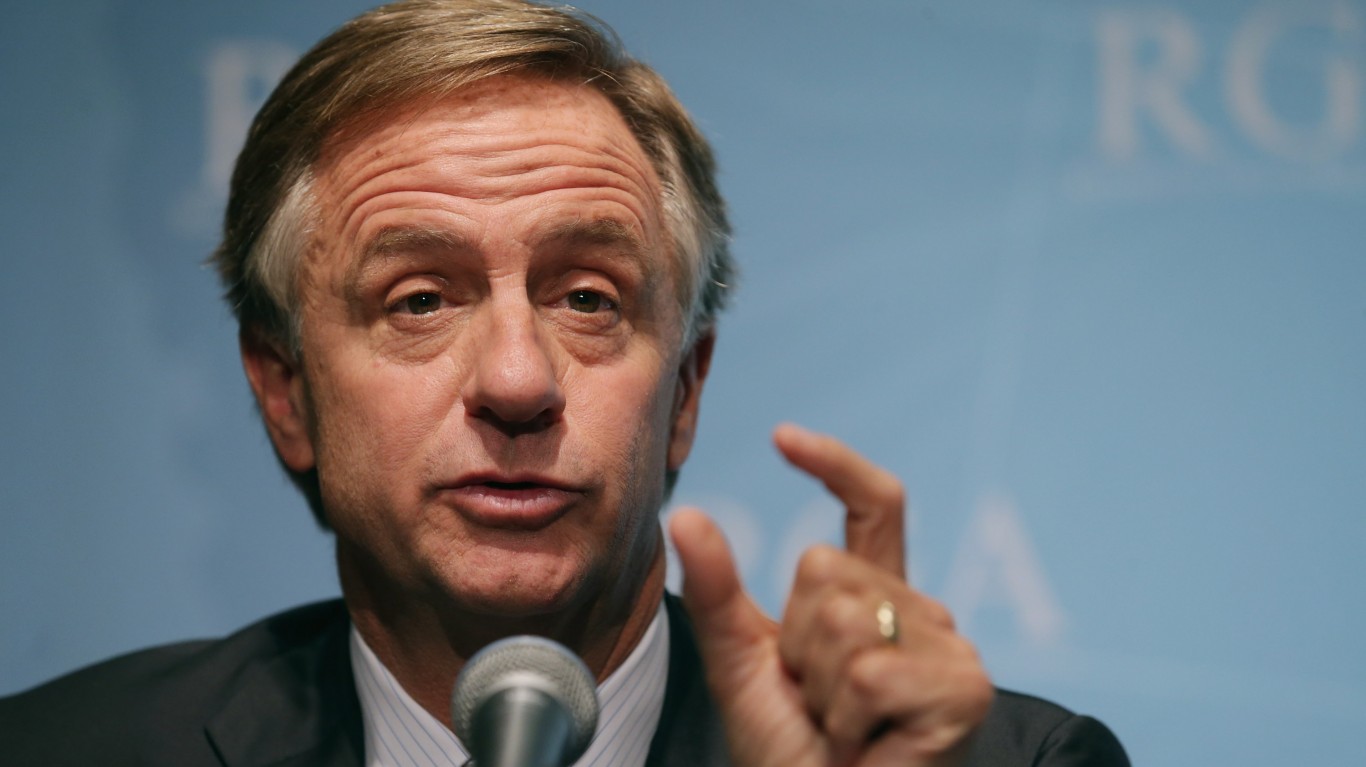
11. Gov. Bill Haslam (R) of Tennessee
> Approval rating: 55%
> Disapproval rating: 24%
> Tenure: 8 years
> Nov. 2018 state unemployment: 3.6% (22nd lowest)
Republican Bill Haslam was elected to office in 2010 and again in 2014. Restricted by state law, Haslam did not seek a third term. Haslam leaves office as the 11th most popular governor in the United States.
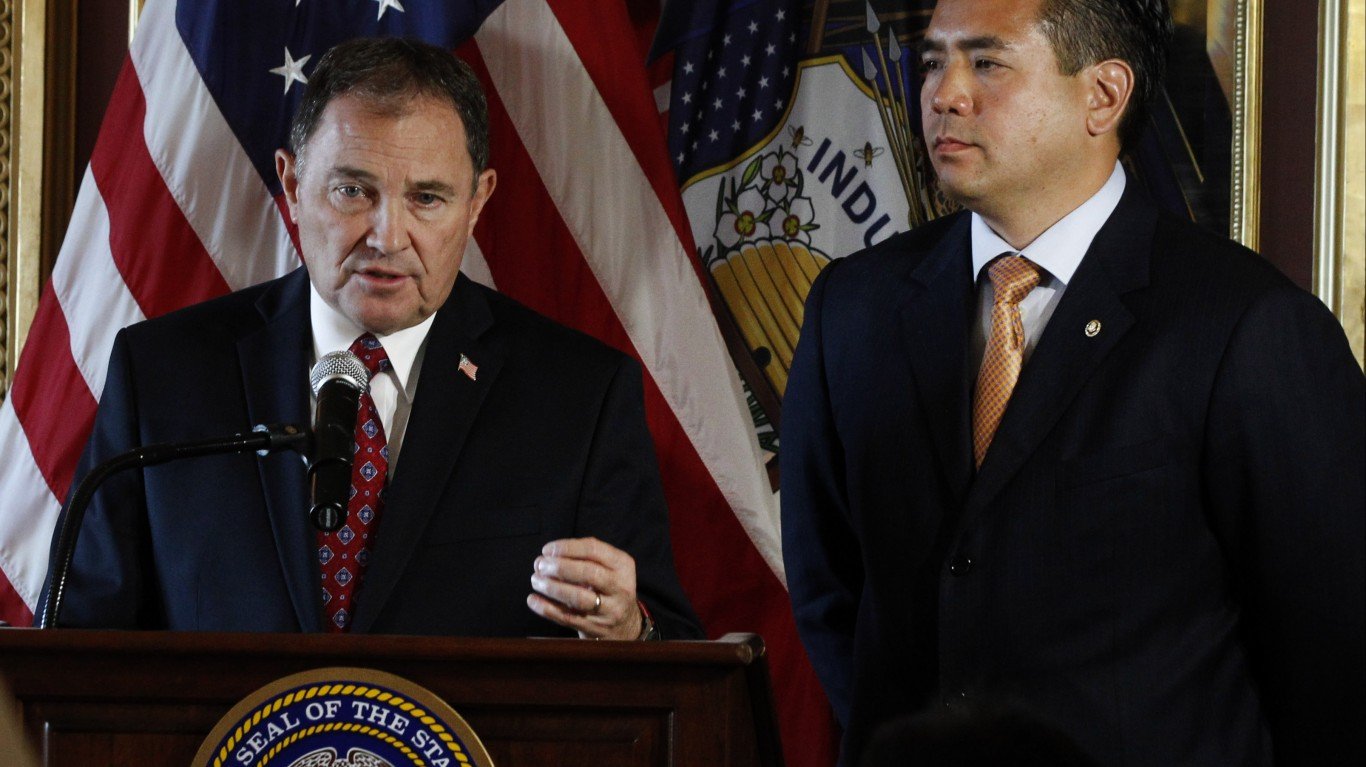
10. Gov. Gary Herbert (R) of Utah
> Approval rating: 56%
> Disapproval rating: 26%
> Tenure: 9 years
> Nov. 2018 state unemployment: 3.2% (13th lowest)
Republican Gary Herbert first served as Utah’s Lieutenant Governor under Jon Huntsman and took over as governor when Huntsman was appointed to ambassador to China in August 2009. Herbert has been voted back in three times, including a special election in 2010. His current term does not end until 2021. Utah does not place term limits on governors.
[in-text-ad]
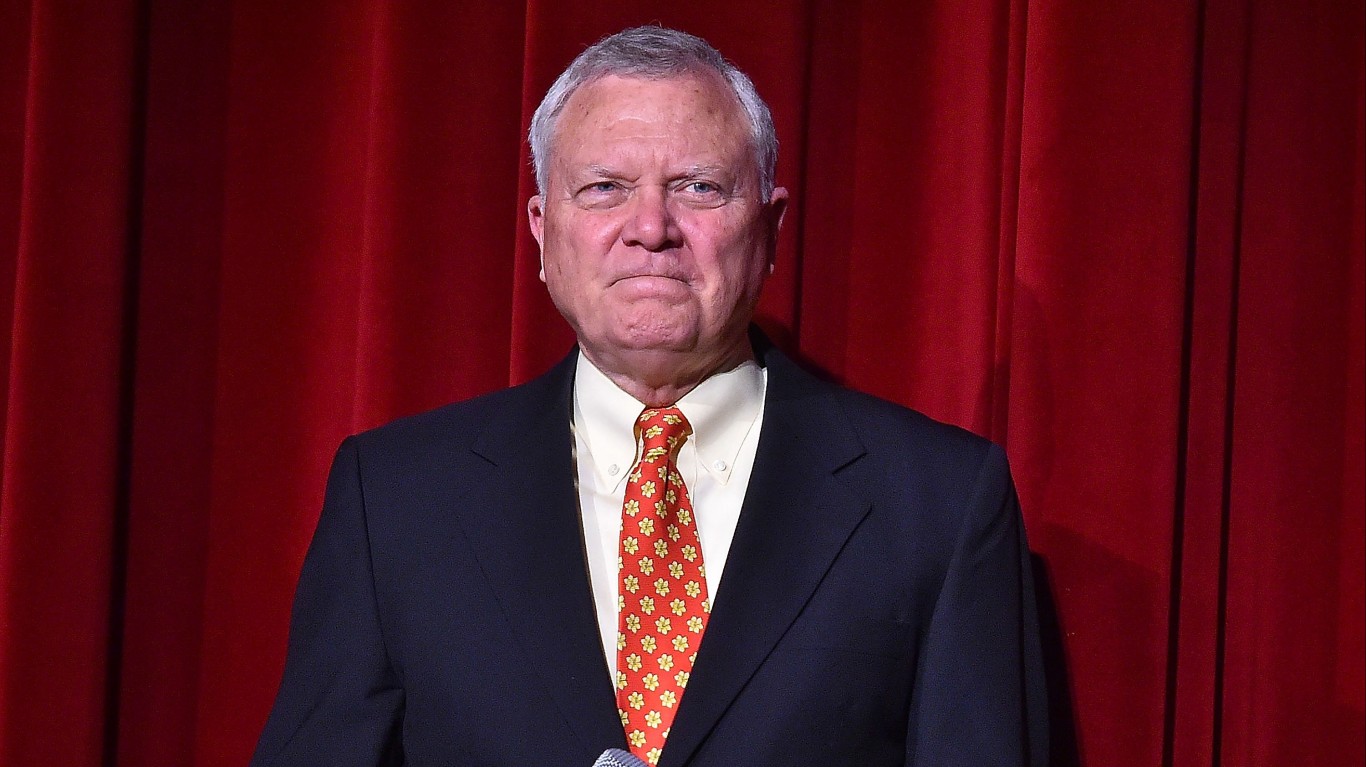
9. Gov. Nathan Deal (R) of Georgia
> Approval rating: 56%
> Disapproval rating: 24%
> Tenure: 8 years
> Nov. 2018 state unemployment: 3.5% (21st lowest)
Republican Nathan Deal was elected to office in 2010 and again in 2014. Restricted by state law, Deal did not seek a third term. Republican Brian Kemp takes office in January 2019 and Deal will depart as one of the 10 most popular governors.

8. Gov. Brian Sandoval (R) of Nevada
> Approval rating: 56%
> Disapproval rating: 23%
> Tenure: 8 years
> Nov. 2018 state unemployment: 4.4% (9th highest)
Restricted by term limits, Republican Brian Sandoval leaves office in January 2019 after serving for two terms. He is among the 10 most popular state governors with a 56% approval rating.
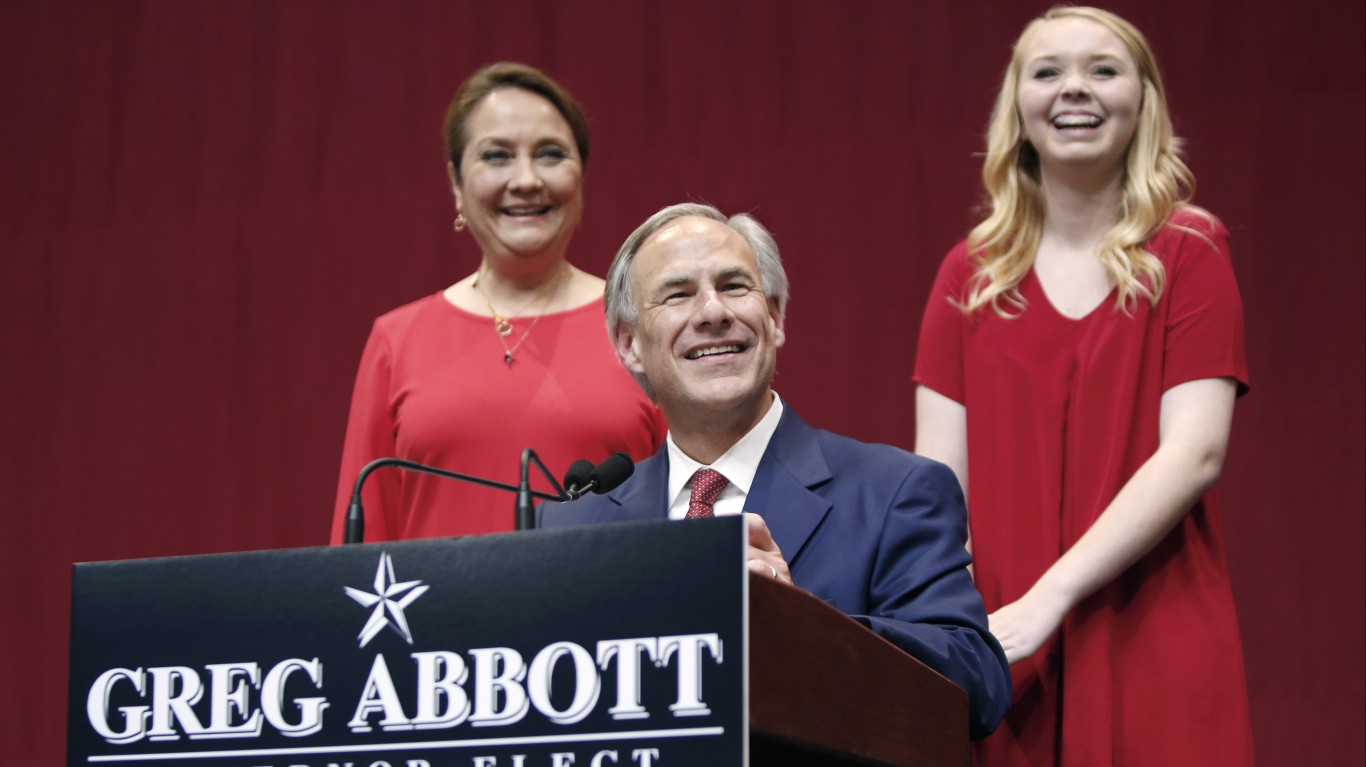
7. Gov. Greg Abbott (R) of Texas
> Approval rating: 57%
> Disapproval rating: 26%
> Tenure: 4 years
> Nov. 2018 state unemployment: 3.7% (25th highest)
Republican Greg Abbott was first voted into the Texas Governor’s office in November 2014. Riding a near nation-leading 57% approval rating, Abbott defeated Democratic challenger Lupe Valdez in November 2018 by a 13.3 point margin. State laws do not restrict Abbott from seeking a third term.
[in-text-ad-2]
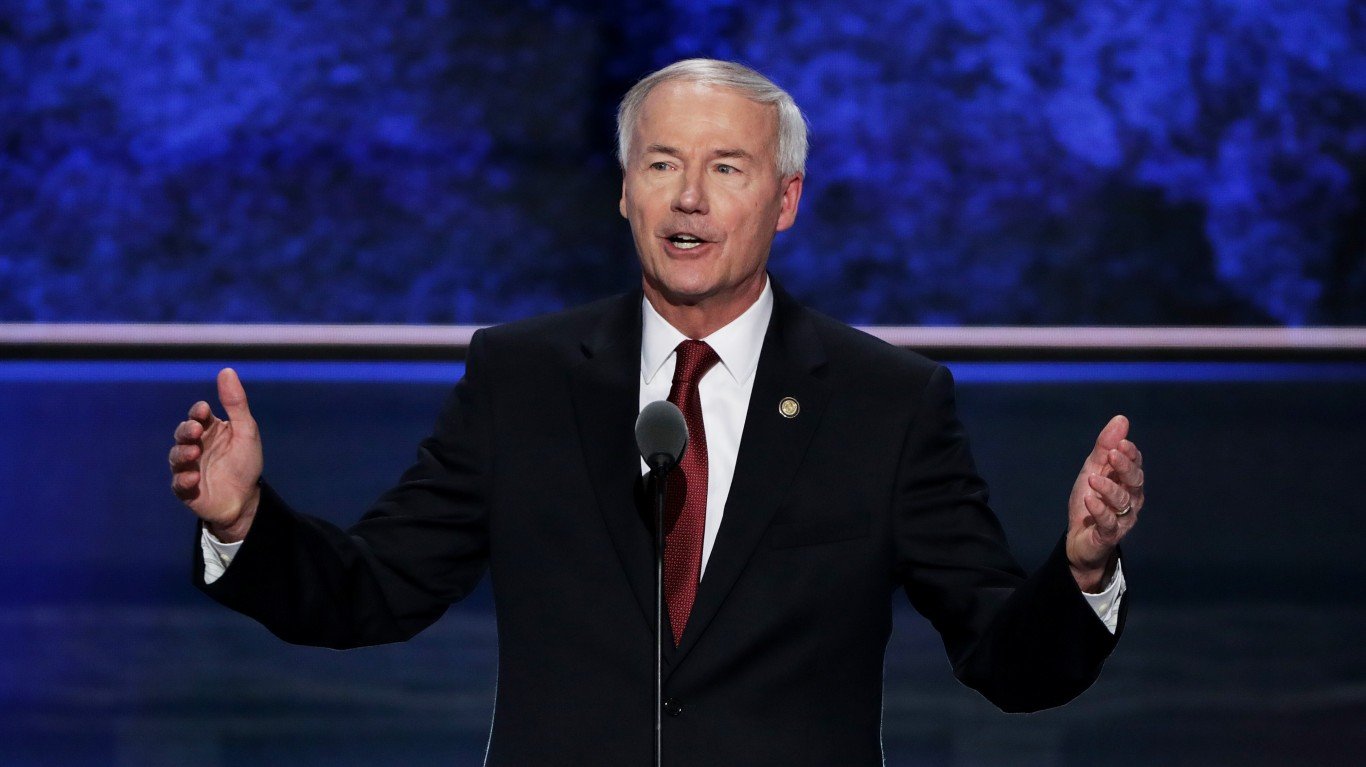
6. Gov. Asa Hutchinson (R) of Arkansas
> Approval rating: 58%
> Disapproval rating: 26%
> Tenure: 4 years
> Nov. 2018 state unemployment: 3.6% (22nd lowest)
Asa Hutchinson took office in January 2015. One of the most popular governors running for re-election, Hutchinson defeated Democratic challenger Jared Henderson by a staggering 33.7 point margin in November 2018. Hutchinson is prohibited by state law from seeking a third term in 2022.

5. Gov. Dennis Daugaard (R) of South Dakota
> Approval rating: 59%
> Disapproval rating: 27%
> Tenure: 8 years
> Nov. 2018 state unemployment: 3.0% (10th lowest)
Forced out by term limits, Republican Dennis Daugaard left office in January 2019 after serving as Governor of South Dakota for two consecutive terms. Republican Kristi Noem now serves as state governor.
[in-text-ad]

4. Gov. Chris Sununu (R) of New Hampshire
> Approval rating: 60%
> Disapproval rating: 24%
> Tenure: 2 years
> Nov. 2018 state unemployment: 2.5% (3rd lowest)
In New Hampshire, governors are voted in on a two year basis, and after taking office in January 2017, Republican Chris Sununu was elected to a second term in November 2018. New Hampshire does not impose term limits on its governors.

3. Gov. Kay Ivey (R) of Alabama
> Approval rating: 65%
> Disapproval rating: 18%
> Tenure: 2 years
> Nov. 2018 state unemployment: 4.0% (18th highest)
Republican Kay Ivey first took office as lieutenant governor in 2011 and took the top job when former Gov. Robert Bentley resigned following an ethics investigation in April 2017. Re-elected in November 2018, Ivey has the third highest approval rating of any U.S. governor.
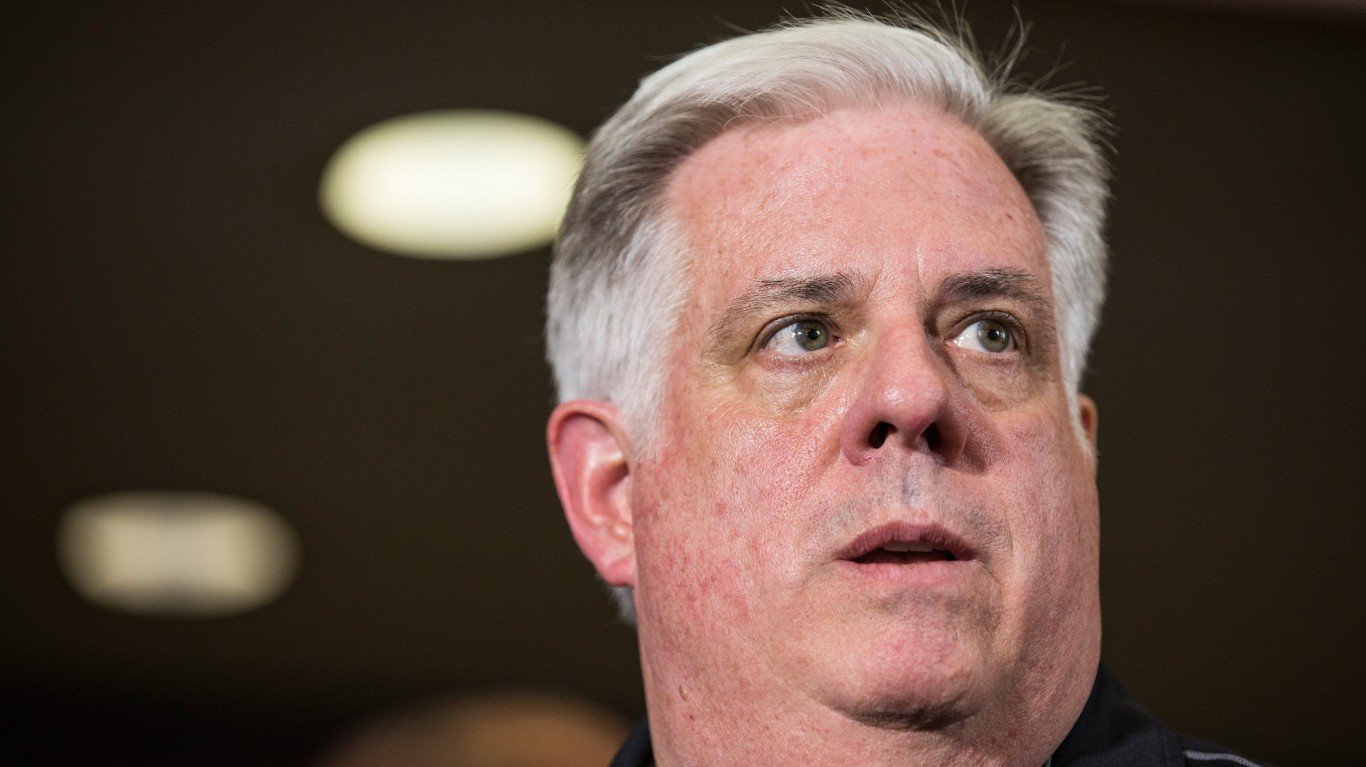
2. Gov. Larry Hogan (R) of Maryland
> Approval rating: 67%
> Disapproval rating: 17%
> Tenure: 4 years
> Nov. 2018 state unemployment: 4.0% (18th highest)
Republican Larry Hogan first took office in January 2015. With a near nation-leading 67% approval rating, Hogan defeated Democratic challenger Ben Jealous by 13.4 points margin in November 2018. Maryland state law restricts Hogan from seeking a third term in 2022.
[in-text-ad-2]
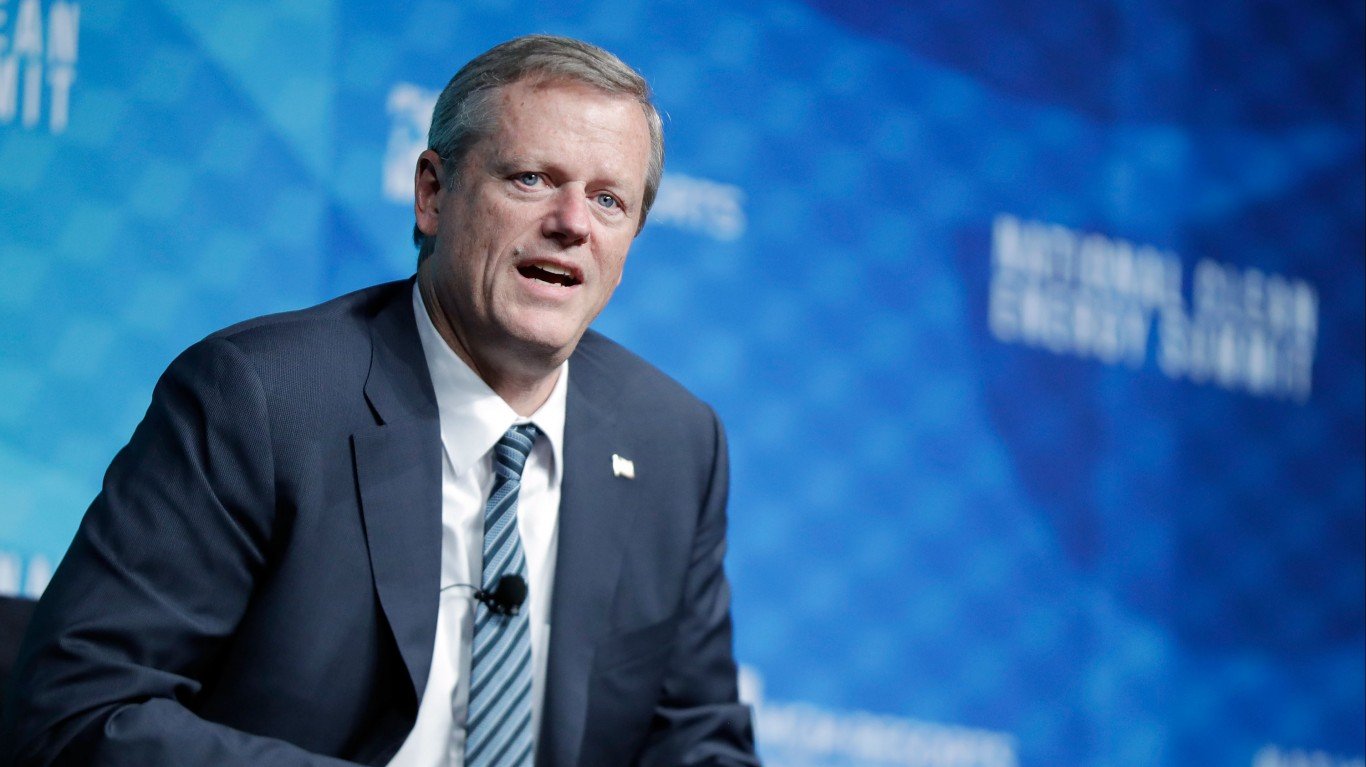
1. Gov. Charlie Baker (R) of Massachusetts
> Approval rating: 70%
> Disapproval rating: 17%
> Tenure: 4 years
> Nov. 2018 state unemployment: 3.4% (19th lowest)
Massachusetts Gov. Charlie Baker is the most popular governor in the country with a 70% approval rating as of October 2018. First elected governor in November 2014, Baker won re-election in November 2018 against Democratic challenger Jay Gonzalez by a 33.6 point margin. Massachusetts does not impose term limits on governors.
Sponsored: Want to Retire Early? Here’s a Great First Step
Want retirement to come a few years earlier than you’d planned? Or are you ready to retire now, but want an extra set of eyes on your finances?
Now you can speak with up to 3 financial experts in your area for FREE. By simply clicking here you can begin to match with financial professionals who can help you build your plan to retire early. And the best part? The first conversation with them is free.
Click here to match with up to 3 financial pros who would be excited to help you make financial decisions.
Thank you for reading! Have some feedback for us?
Contact the 24/7 Wall St. editorial team.
 24/7 Wall St.
24/7 Wall St. 24/7 Wall St.
24/7 Wall St. 24/7 Wall St.
24/7 Wall St. 24/7 Wall St.
24/7 Wall St. 24/7 Wall St.
24/7 Wall St.
